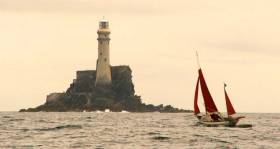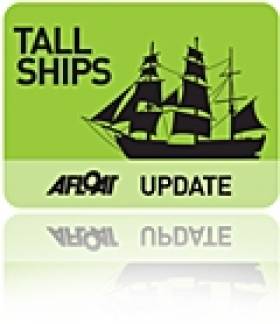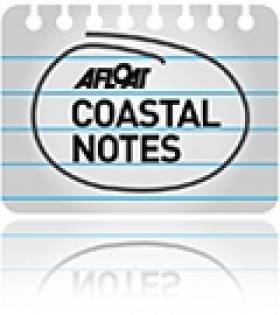Displaying items by tag: Old Gaffers
Galway Hooker 'Blát na hÓige' is Asgard Trophy Race Winner at Dublin Bay Old Gaffers Diamond Jubilee
It was well worth the significant logistical effort of skipper Aongus Ó Cualáin to transport his Galway Hooker Blát na hÓige from Connemara to Dublin's River Liffey by road last week as the 1896-built traditional vessel won first prize in Saturday's Dublin Bay Old Gaffers Association Diamond Jubilee celebration, bringing home to County Galway the prestigious DBOGA Asgard Trophy.
 White-sailed Hooker: With white sails as opposed to the more popular tan, plus battens in the main and staysail, winner Blát na hÓige cuts a unique pose at a turning mark in Saturday's Dublin Bay Old Gaffers Association Asgard Trophy race Photo: Afloat
White-sailed Hooker: With white sails as opposed to the more popular tan, plus battens in the main and staysail, winner Blát na hÓige cuts a unique pose at a turning mark in Saturday's Dublin Bay Old Gaffers Association Asgard Trophy race Photo: Afloat
Blát na hÓige was transported overland to compete in the annual race and was launched into the capital's waters close to the Thomas Clarke Bridge on the River Liffey, where her mast was re-stepped and the trad boat re-rigged all in time for the weekend's racing.
 Connemara bound - the winning Blát na hÓige are pictured on the River Liffey campshire all packed and ready for the long road home after a successful trip to the capital's waters
Connemara bound - the winning Blát na hÓige are pictured on the River Liffey campshire all packed and ready for the long road home after a successful trip to the capital's waters
Fourteen gaff-rigged boats competed for the big prize from a total fleet of 40 yachts and dinghies that gathered at Dublin Port for two days to celebrate the 60th anniversary overseen by DBOGA President Adrian Spence, as Afloat reports here.
 Conceived initially as a Gleoiteog in 1896, a Galway Hooker size that ranges in length from 7 to 9 metres (24 to 28 feet), when Blát na hÓige's keel timbers arrived, they were deemed of such top quality that it would be a shame to cut them so she was built at 28-foot and four inches in length thus becoming a 'Gleoiteog-Mor' and unique addition to the Hooker fleet of Lettermullan island
Conceived initially as a Gleoiteog in 1896, a Galway Hooker size that ranges in length from 7 to 9 metres (24 to 28 feet), when Blát na hÓige's keel timbers arrived, they were deemed of such top quality that it would be a shame to cut them so she was built at 28-foot and four inches in length thus becoming a 'Gleoiteog-Mor' and unique addition to the Hooker fleet of Lettermullan island
The primary race of the event for the Asgard Trophy was run by Poolbeg Yacht and Boat Club's Principal Race Officer John Alvey and was held out in Dublin Bay in light airs of seven to 10 knots.
Other runners included the Isle of Man Master Frank, a Manx half-deck fishing boat, and the 52-foot Letty, a vintage Bristol Channel Pilot Cutter.
The Asgard half-model trophy is a much sought-after prize in Old Gaffer circles as Asgard conservator John Keraon designed the award, and it contains a part of Asgard's original timber as part of the trophy.
 Galway Hooker Blát na hÓige skipper Aongus Ó Cualáin with some of his trophy haul that also included first Working boat Prize from the Dublin Bay Old Gaffers Association Diamond Jubilee celebration at Poolbeg Yacht and Boat Club
Galway Hooker Blát na hÓige skipper Aongus Ó Cualáin with some of his trophy haul that also included first Working boat Prize from the Dublin Bay Old Gaffers Association Diamond Jubilee celebration at Poolbeg Yacht and Boat Club
The winning crew comprised Ó Cualáin, his brother Fergus, Michael Mulkerrin, John Geoghegan, Jimmy McCormack and Donal Green.
As soon as the weekend was over, the Gleoiteog-Mor went west to rejoin Connemara's busy summer Galway Hooker racing circuit.
Sean Walsh's Tir N’Og won Class Two.
The Small Gaffers was won by Wren, with Onward of Ito second.
The winner of the 100 euro purse for the first RBC 60 boat to cross the finish line was the Bristol Channel Pilot Cutter Letty.
Dun Laoghaire Bicentenary Sailing Regatta Takes on Interesting New Acts
With some visionary thinking by Cathy MacAleavey in her capacity as chief of the sub-committee organising the Classics, Traditional and Old Gaffers section of the Volvo Dun Laoghaire Regatta & Harbour Bicentenary Festival from June 6th to 9th, the scope of the event is going to become even more varied and certainly more colourful. As W M Nixon has discovered, she has been spreading the net wide:
“We’ve never been asked to take part in a regatta before. Never. So of course we’ll be there. And I personally am looking forward to it very much indeed.”
The speaker is Jack O’Keeffe of Cork, one of the main men in the Irish Drascombe Association, and also the overall association’s organizer of Rallies. While his members with their distinctive and extensive selection of tanned-sailed little boats are a familiar sight in Ireland and elsewhere as they stage their various rallies and other events, despite the well-known distinctive blue-green hull colour with which they were introduced being known throughout the country, nobody seems to have thought of them before as worthy participants as a class of their own. Not even as part of a menagerie class in a local regatta, let alone as playing a significant role in major events. But Cathy did her usual bit of lateral thinking, and the result is a whole new fleet for the Dun Laoghaire festivities.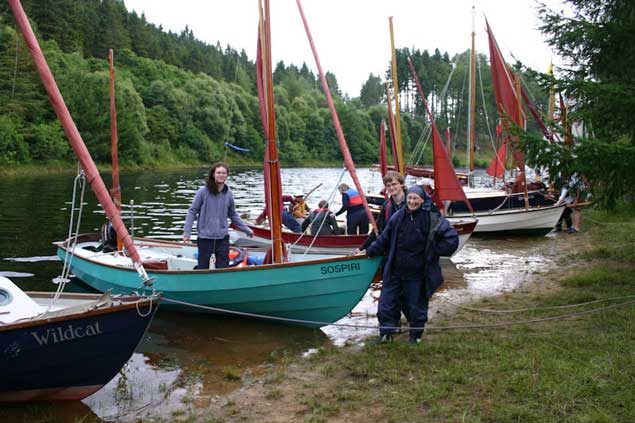 Traditional perceptions remember the Drascombes as all having that distinctive blue-green colour, but they’ve been multi-hued for years.
Traditional perceptions remember the Drascombes as all having that distinctive blue-green colour, but they’ve been multi-hued for years.
In Dun Laoghaire, the very fact that the Drascombes within their different types are broadly One-Design should see them encouraged, for in the home of One Design racing, it is only relative speed which is significant. Broadly speaking, every Drascombe will be sailing at much the same fairly leisurely speed, and they’ll all be manoeuvring in sync with that admirable Drascombe dignity. If that’s not a formula for good one-design racing, then I don’t know what is.
Yet while they may not break world sailing speed records, Drascombes certainly do sail – think of the Ogden brothers who sailed round Ireland in their Drascombe Lugger in some decidedly rugged conditions in 2015. Others, believe it or not, have crossed oceans. And on top of that, if they have managed to wend their way into the head of some peaceful creek at the end of day’s sailing, the lack of shore facilities is no problem, as most Drascombes provide rudimentary accommodation, quite commodious in some cases.
 "We’ve done it!” The Ogden brothers sail their Drascombe back into Baltimore at the completion of their round Ireland cruise.By a happy coincidence, 2017 is a special year, as it more or less marks the Golden Jubilee of the time Devon boat-builder John Watkinson started designing characterful seaworthy little boats which reflected the rigs of earlier times. It was in 1968 that he took the final 1967-built prototype to the London Boat Show and sold her within 20 minutes of opening, coming home with orders for 19 sister-ships to a concept whose popularity is proven by the fact of there now being 5,000 currently afloat.
"We’ve done it!” The Ogden brothers sail their Drascombe back into Baltimore at the completion of their round Ireland cruise.By a happy coincidence, 2017 is a special year, as it more or less marks the Golden Jubilee of the time Devon boat-builder John Watkinson started designing characterful seaworthy little boats which reflected the rigs of earlier times. It was in 1968 that he took the final 1967-built prototype to the London Boat Show and sold her within 20 minutes of opening, coming home with orders for 19 sister-ships to a concept whose popularity is proven by the fact of there now being 5,000 currently afloat.
The Golden Jubilee celebrations have already got under way with a party at the recent London Boat Show, but thanks to the Drascombe Association’s tradition of having the annual conference and dinner in the home town of the current overall chairman, the big party is going to be in Belfast City Hall on the weekend of March 25th to 26th, as the Drascombe Association’s Chairman of for 2017 is John Stanage of Belfast.
 A remarkable setting for the Drascombe Association’s Golden Jubilee celebration at the end of March 2017 – Belfast City Hall, completed in 1906, was an exuberant expression of a rapidly-growing city at the height of its industrial power.
A remarkable setting for the Drascombe Association’s Golden Jubilee celebration at the end of March 2017 – Belfast City Hall, completed in 1906, was an exuberant expression of a rapidly-growing city at the height of its industrial power.
Heaven only knows what Drascombe sailors from elsewhere will make of Ireland’s built environment if they attend the events both in Belfast in March, and in Dublin Bay in July. Belfast City Hall was such an exuberant expression of the city’s rocketing prosperity when it was completed in 1906 that its gloriously over-the-top Baroque Revival style was promptly copied by major civic buildings elsewhere. As for the rather more austere Kingstown Harbour - which will probably briefly revert to its imperial name during the Bicentenary Regatta - not only is the harbour a massively impressive structure on such a scale that it now seems a natural part of the bay, but its waterfront has a trio of yacht club buildings which, while the they don’t begin to match Belfast City Hall’s opulence, are quite something by comparison with your average sailing club.
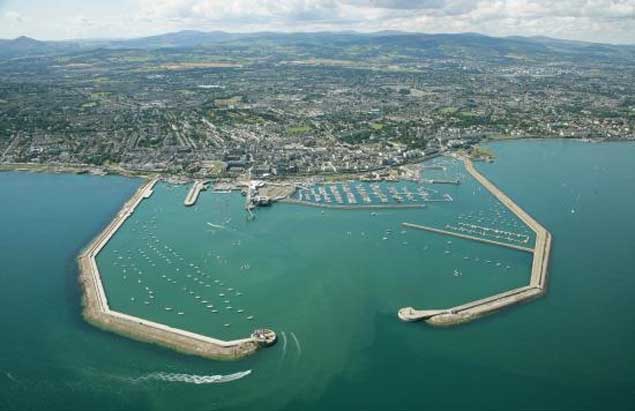 For smaller Drascombes, Dun Laoghaire Harbour is a complete cruising ground within itself
For smaller Drascombes, Dun Laoghaire Harbour is a complete cruising ground within itself
One of the reasons the Drascombes came up on the Dun Laoghaire radar is because the Sub-Committee were particularly impressed by the vibrant trailer-sailer section which is now to be found in the Old Gaffers Assocation, a section in which Drascombes play a signficant part.
It’s of interest that the OGA themselves have lately been paying closer attention to encouraging designs for smaller gaffers of good performance potential, and at the AGM in London last month, outgoing OGA President Sean Walsh of Dublin was able to unveil preliminary drawings of a concept by that versatile designer Andrew Wolstenholme of a 13ft 6ins “modern mini-gaffer” which the OGA wishes to encourage, with ease of amateur building a priority.
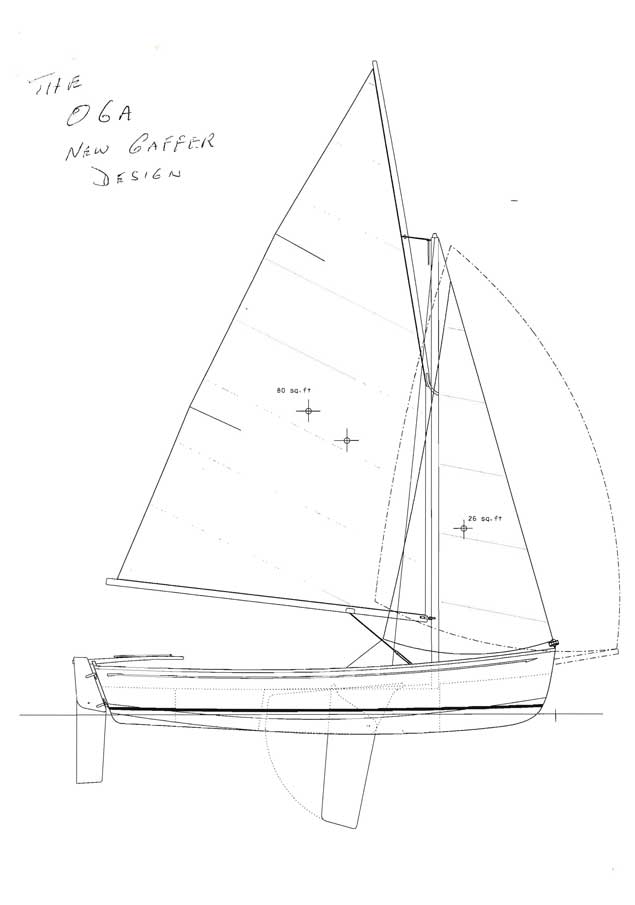 Concept drawing from Andrew Wolstenholme for the new 13ft 6ins “performance mini-gaffer” to be sponsored by the Old Gaffers Association
Concept drawing from Andrew Wolstenholme for the new 13ft 6ins “performance mini-gaffer” to be sponsored by the Old Gaffers Association
Equally Sean – who himself sails the 28ft Heard Falmouth Cutter Tir na nOg, a “plastic fantastic” – wished to record his own and the OGA’s appreciation of the work over the years of another boat designer from southwest England, and this is Roger Dongray, a house architect who many years ago found himself starting to design the little plastic gaffers which went on to become the Cornish range of Shrimpers, Crabbers and whatever, every one of them a characterful little boat which gives much pleasure and the extra sport of handling gaff rig to owners who have neither the resources nor skills to maintain an ageing wooden boat.
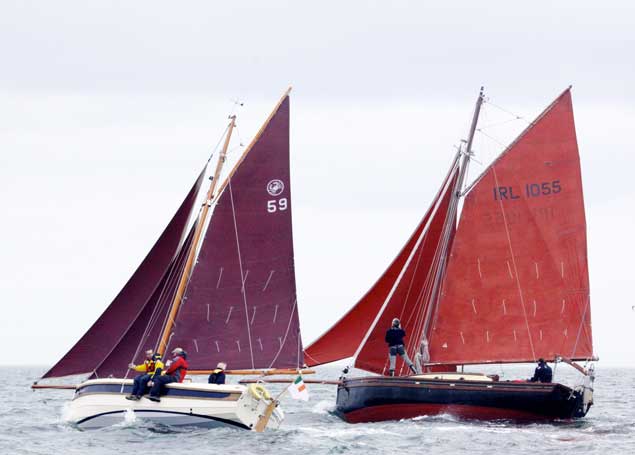 Dublin Bay OGA President Denis Aylmer’s Cornish Crabber Mona (left) and outgoing OGA President Sean Walsh’s Heard 28 Tir na nOg Photo: Dave Owens
Dublin Bay OGA President Denis Aylmer’s Cornish Crabber Mona (left) and outgoing OGA President Sean Walsh’s Heard 28 Tir na nOg Photo: Dave Owens
So Sean’s final duty before standing down, to be succeeded as President by Alistair Randall, was a formal presentation to acknowledge Roger Dongray’s special work in making gaffers interesting to modern-minded owners, and his skill in creating a recognisable style in a range of fibreglas-built gaff-rigged boats which are an adornment to any port or anchorage.
 The versatile Cornish Shrimper is one of Roger Dongray’s most popular designs.
The versatile Cornish Shrimper is one of Roger Dongray’s most popular designs.
In an era when the advent of foils means that we are seeing mono-hulls which have the potential to move at meaningless speeds, the sheer pleasure of coaxing the best performance out of a comfortable and characterful gaffer, aboard which your young family feels comfortable and secure, is something to be treasured, and it intrigued me to hear the other day that Olivier Prouveur, the Sailing Manager at the National YC and highly experienced in many kinds of craft, has bought himself a Cornish Shrimper as he reckons a boat like this provides very well for Dun Laoghaire sailing requirements – and yes, he does hope to race her for the Kingstown Cup in July.
Another area of possible participation where Cathy MacAaleavey has been casting her net is the three-masted Bantry Boats, but a problem she has discovered is that several are short of crews. One particular case is the one which was built in a community project at Banagaher on the Shannon, but unfortunately the key man in all this has moved on elsewhere, and they’ve a personnel problem.
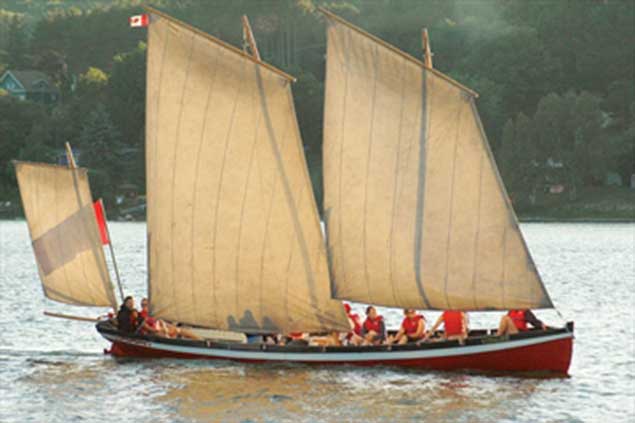 Bantry Boats need a lot of crew
Bantry Boats need a lot of crew
This in turn has opened up the possibility of the thriving coastal rowing clubs being a source of crewmen for the Bantry boats, for thanks to the enthusiastic support of the legendary Ger Ryan of St Michael’s Rowing Club underneath the arches beside Dun Laoghaire’s inner harbour, the outer harbour is going to be packed out with skiff racing crews from near and far on Sunday July 9th.
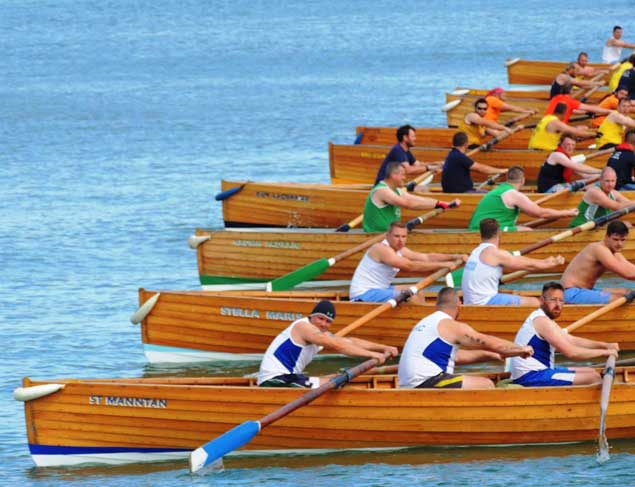 Manpower….the East Coast Rowing craft are an ancient style of boat going back to the era of the Dublin Bay hobblersFrom that comes the idea of an invitation being cast in the direction of the rowing skiffs of Strangford Lough. They’re much lighter and smaller boats than the traditional hefty East Coast craft which date back to the hobblers’ service boats of the 18th and 19th century. In Strangford Lough by contrast they used a highly-regarded Iain Ougthtred easy-build design, and a league developed as noted harbour pubs around the lough organized boat-building classes to provide an Oughtred skiff apiece. There are now nine boats which regularly turn out to race together, and it is of course thirsty work, which was probably the thinking all along.
Manpower….the East Coast Rowing craft are an ancient style of boat going back to the era of the Dublin Bay hobblersFrom that comes the idea of an invitation being cast in the direction of the rowing skiffs of Strangford Lough. They’re much lighter and smaller boats than the traditional hefty East Coast craft which date back to the hobblers’ service boats of the 18th and 19th century. In Strangford Lough by contrast they used a highly-regarded Iain Ougthtred easy-build design, and a league developed as noted harbour pubs around the lough organized boat-building classes to provide an Oughtred skiff apiece. There are now nine boats which regularly turn out to race together, and it is of course thirsty work, which was probably the thinking all along.
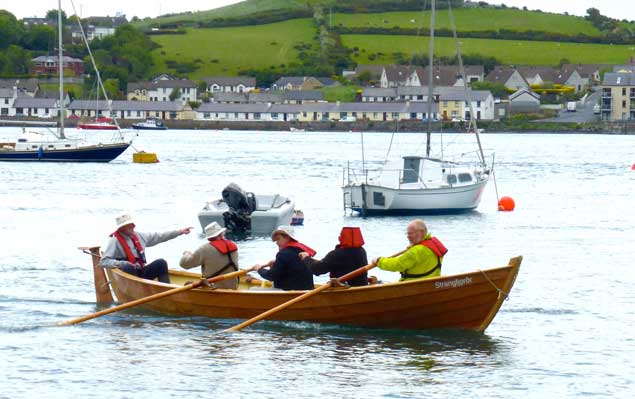 The Iain Oughtred-designed skiffs have established a league in Strangford Lough Photo W M Nixon
The Iain Oughtred-designed skiffs have established a league in Strangford Lough Photo W M Nixon
Whether or not they come to Dun Laoghaire in July is another matter altogether, interesting and all as it would be. But either way, we can be sure that the hugely varied fleet which is now shaping up for the Classics, Old Gaffers and Traditional Division of the Volvo Dun Laoghaire Bicentenary Regatta 2017 will find that whole-hearted participation is indeed very thirsty work.
#Riverfest - The Dublin Bay Old Gaffers Association has timed its annual regatta to take place this weekend during the third Dublin Port Riverfest.
Weather permitting, the DBOGA will race in Dublin Bay for the Leinster Plate Trophy on Saturday 30 May, while on Sunday 31 May they will sail upriver to berth along the north quays and enjoy the festival's atmosphere before parading back to the Poolbeg Boat and Yacht Club.
Then on Bank Holiday Monday 1 June they will join an even bigger parade of sail to salute the departing tall ships – including the square rigger Kaskelot.
More details on the Old Gaffers' weekend plans – and how you can join in the fun – are available HERE.
And don't forget this summer's cruise in company along the 'Fastnet coast' in West Cork.
2015 Sailing Calendar Includes Two Bicentenaries & Ireland's Biggest Regatta At Dun Laoghaire
Irishsailing – After the remarkable across-the-board success of the 2014 Irish sailing season, 2015 will have to be very special indeed to be remembered with such enthusiasm. But it's a special year in any case, as two major sailing Bicentenaries – one in the Irish Sea, the other in the Solent – will have added and poignant meaning, as the Centenaries a hundred years ago could not be celebrated because of the First World War.
As for Irish sailing generally, life moves on, there are new sailors on the water, successful young sailors are graduating to the next stage of their rapidly developing careers, and established stars continue to plan fresh campaigns, for sailing is indeed a sport for life.
Then too, new fixtures successfully introduced in 2014 will require nurturing, tuning and encouragement if they are to fulfil their potential in the coming year, while at the same time there's always extra effort needed to give proper support to established fixtures, which have to live with the reality that they might wilt through being taken for granted. Both new and longer-established boat classes will need continued enthusiastic involvement, and our well-loved classics and traditional craft must be cherished and sailed, for lack of use is the real enemy of boats, whether old or new.
As for the major administrative initiatives introduced in 2014, they will need constant monitoring, but deserve full support from the sailing and boating community at large, for it was in response to a grass-roots initiative that the radical and very necessary reforms of the Irish Sailing Association were undertaken. Those appointed to undertake the root-and-branch reform of the national authority have done so with commendable dispatch, so it is now the duty of the rest of us to support their continuing efforts. And we can best do that by enjoying our boats and our sailing and time afloat in its myriad of interests, while encouraging others to do the same. W M Nixon outlines on what the coming year may bring.
One thing at least is certain for the coming season afloat during 2015 in most of Europe. It will not mark any significant sailing Centenaries. Instead, we are immersed in four years of remembering the Great War of 1914-1918 a hundred years on, with all the added twists of that period's longer historical narrative in Ireland. In such a context, it may seem frivolous to point out that sports like yachting have no great Centenaries to mark at all in 2015. But this minor off-screen fact is a reminder of the all-involving horror and obscenity of total warfare on an industrial scale. It obliterated anything like normal life.
Yet as recreational sailing had been going on in some sort of organised form for hundreds of years – albeit in a fairly rudimentary way in its earliest years in the 16th Century – there may well have been several important dates to be marked during the time of the Great War itself, but they were allowed to pass as there was no sport afloat, while civilian life ashore was very subdued.
And in Ireland, with the Troubles persisting for four years after the end of the Great War until 1922, the Bicentenary of the Royal Cork Yacht Club in 1920 was to be a muted affair – the official History of the Royal Cork Yacht Club (published 2005) tells us: "Plans for a special dinner to celebrate the club's bicentenary in 1920 had to be cancelled, probably because of the disturbed conditions in the country"
So the idea of celebrating the Centenary of the Royal Yacht Squadron in Cowes in 1915 at the height of the international war - other than in a rather solemn shorebound way - would have been unthinkable. But that in turn fuels the celebrations when the peacefulgood times roll again. Thus the Royal Cork Yacht Club, having been unable to celebrate its Bicentenary in 1920, went on to have a fabulous two-year Quarter Millennium celebration in 1969-70. And as the RYS couldn't have a proper party in 1915, there's no doubt that the up-coming Bicentenary in 2015 will be the nucleus of international sailing's megafest-of-the-year.
There are of course several clubs which pre-dated the Squadron when it was founded in 1815. And there are many whose members outshine the small membership of the RYS in the breadth and energy of their sailing. But for 2015, let's just acknowledge that the prestigious Squadron has been at the heart of sailing history for a very long time, while their clubhouse's location right on the Solent at Cowes is so central that when any great Solent-related events are under way, the Squadron is in the middle of the story.
Thus it was on the Squadron lawn that in July that the Irish team celebrated their epic Commodore's Cup victory at the end of July 2014. And it will be towards the Squadron and its Bicentenary that the fleet will be racing in 2015's west-east Transatlantic Race. And then it will be the firing of the cannons from the historic Squadron battery which will signal the start of the 46th Fastnet Race on 16th August 2015.
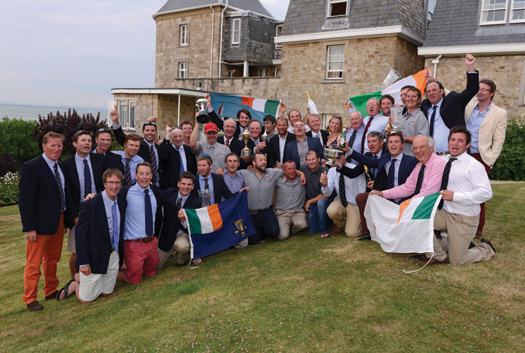
Party time at the Royal Yacht Squadron – the Irish team and their management gather to celebrate victory in the Commodore's Cup at the Squadron Castle in Cowes on August 1st 2014
There'll be many Irish boats involved, and the best-placed of them at the finish will be the winner of the Gull Salver, currently held by Martin Breen's Reflex 38 Lynx from Galway Bay SC, which was skippered to success by Aodhan FitzGerald in 2013's race. It's a coveted trophy, instituted to honour the memory of Harry Donegan of Cork and his famous cutter Gull, which was one of seven boats which inaugurated the Fastnet Race in 1925, and placed third. Since then, Irish Fastneteers have frequently been in the great race's top places, and best of all was in 2007 when Ger O'Rourke's Cookson 50 Chieftain out of Kilrush, sailing under the burgee of the revived Royal Western of Ireland YC, came sweeping in to the finish line at Plymouth to win the Fastnet Race
overall.
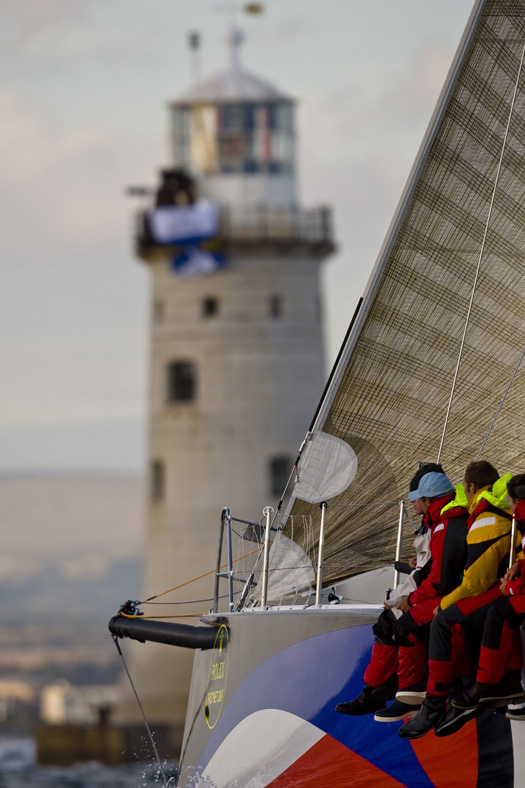
One of the greatest moments in Irish sailing history – Ger O'Rourke's Chieftain sweeps towards the finish line to become the overall winner of the Rolex Fastnet Race 2007. Photo: Rolex
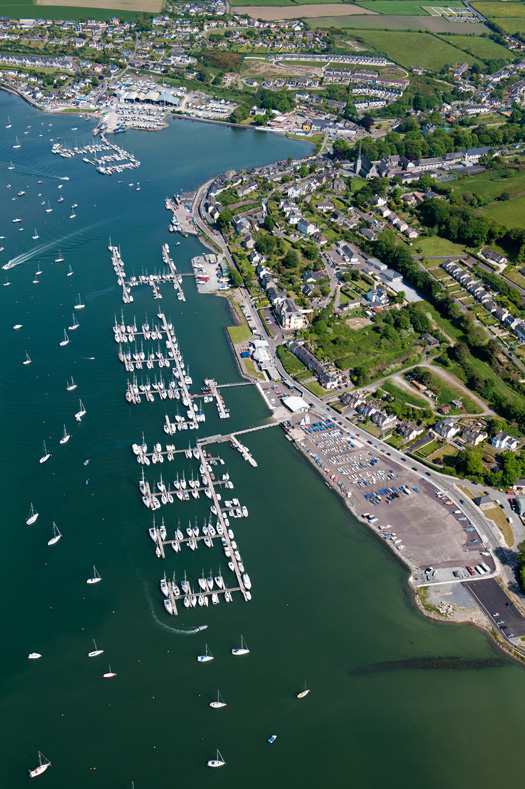
Just the spot for a great Tricentenary celebration - the very complete sailing facilities provided jointly by the Royal Cork Yacht Club and Crosshaven will become a world focus in 2020 with the Club's 300th anniversary. Photo: Bob Bateman
The realisation that 2015 sees this significant RYS Bicentenary is a timely reminder that the Royal Cork's Tricentenary is only five years down the line. They're five years which will be gone in a flash, and already behind-the-scenes moves are afoot to ensure that the national sailing programme will properly facilitate the extraordinary anniversary being celebrated in Crosshaven in 2020.
But meanwhile other Irish sailing centres have their own regular programmes to operate in the intervening four years, and in terms of numbers and scale there's no doubt the top event in Ireland in 2015 will be the biennial Volvo Dun Laoghaire Regatta from 9th to 12th July.
Anyone – and there were many - who took part in this unique "suburban sailfest" in 2013 will know that the VDLR has come of age. It's an event which is comfortable with itself while at the same time being always in development and evolution mode. Each staging of this remarkable Dublin Bay happening sees lessons being learnt and implemented even while the multi-class racing is under way on several courses. And in the two year gap before the next staging, the experience gained is closely analysed and the programme refined to further improve the sport in every area.
You get some idea of the sheer depth of racing experience in Dun Laoghaire by noting that the Chairman of the 2015 Committee is Tim Goodbody, with Martin Byrne as Vice Chairman while the Race Director is Con Murphy. And those three sailing megastars are just the peak of a mountain of race administration experience which is being drawn in from all over Ireland to ensure that the fleet of 400-plus boats gets the best sport possible.
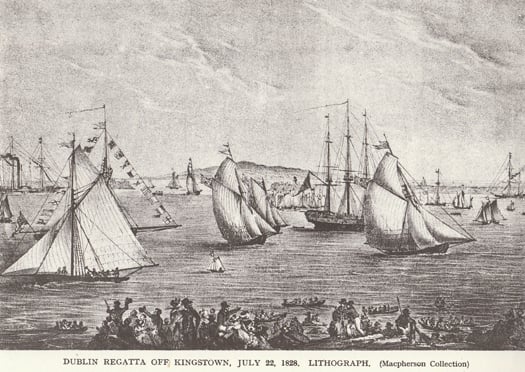
The first regatta in 1828 at the new harbour at Dun Laoghaire, which will be the setting for Ireland's biggest event in 2015, the Volvo Dun Laoghaire Regatta from 9th to 12th July.
While there'll be keenly participating boats from all over Ireland as well as Scotland, England and Wales, the setup of Dublin Bay being right on the city's doorstep means that it's the locals who would pose an administrative problem for a less experienced team. As the dates for the VDLR approached in 2013, the weather forecast steadily improved, and thanks to the Regatta's "extra long weekend" format, the sudden arrival of summer meant that a host of boats from the greater Dublin area came in as last minute entries, their owners and crews managing to scrape the extra day-and-a-half needed off work. It's a scenario which would put an overstretched administration off course, but the VDLR team took it calmly in their stride, and the result was a successful summer festival of sunlit sails and great sport, with maybe two thousand taking part.
This year there's a more structured cross-channel involvement, as the venerable Royal Dee YC in Cheshire has leapt to life to celebrate its Bicentenary. Founded as the Dee Yacht Club in 1815 with the end of the Napoleonic Wars, it didn't get the Royal seal until 1947, but nevertheless claims to be older than the RYS. With growing fleets in North Wales and the Mersey, it has put together a Bicentennial Royal Dee Irish Sea Offshore Championship linked closely to ISORA, which will bring the fleet across to Ireland to take in four offshore day races sailed as part of VDLR 2015.
Irish National Championships which will be part of the VDLR 2015 programme include the J/109s, the RS Elites, the Beneteau First 21s, and the Wayfarers, while the Leinster GP 14 Championship is also included as an integral part of the Regatta.
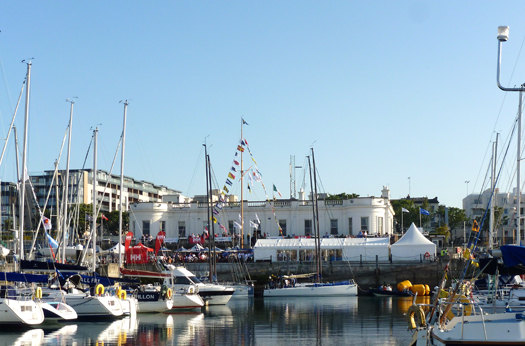
Party time in Dun Laoghaire – the Royal Irish YC during VDLR 2013. Photo: W M Nixon
As for Ireland's classic clinker-built vintage classes, one of the pleasantest surprises in VDLR 2013 was the large turnout of Mermaids, which had superb racing on the course area in the northwest corner of Dublin Bay. Despite having been born as the Dublin Bay SC Mermaid in 1932, this class of 17ft super-dinghies is no longer included in the regular DBSC programme owing to shortage of numbers for weekly turnouts. But it seems that as far as the VDLR is concerned, the Mermaid is now an event boat, and the fleets still thriving at other centres, together with some of the dormant Dublin Bay craft, bestirred themselves for the four days to enjoy good sailing for more than three dozen boats, something which is highly likely to be repeated in 2015.
The even more venerable Water Wags, founded 1887 with the current boats dating from 1903, continue to thrive in Dun Laoghaire, and the word is they expect to have at least twenty boats in action, while another wooden classic, the Mylne-designed 25ft Glen keelboat, is 50 years and more in Dun Laoghaire, and looks forward to having at least twelve boats racing in 2015.
All these specialized and historic classes are in addition to the numerous cruiser-racers which continue to be the backbone of Dublin Bay sailing. And while many of them will see the VDLR 2015 as a highlight of the year, in turning to consider the overall national programme, we find a sport which is shaking off economic recession to get on with an extraordinary plethora of local, national and international sailing events.
The problem is that most events of significance hope to locate themselves in the peak sailing period from late May to early September, so clashes are almost inevitable, and if you're interested in several different kinds of sailing, the overall choices can be bewildering in their complexity and logistical challenges.
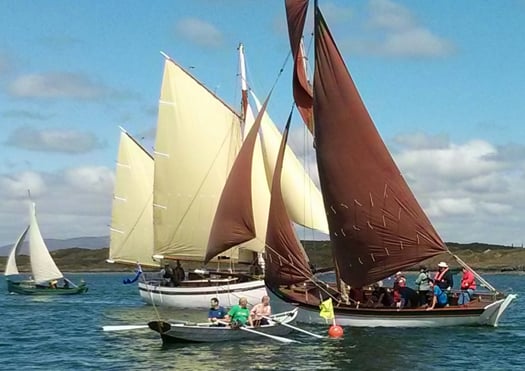
The Baltimore Wooden Boat Festival attracts an eclectic fleet – included here are a Shannon Gandelow, a West Cork Mackerel Yawl, the ketch Sile a Do, and an Heir Island Lobster Yawl (left).
For instance, the variety of events now available for the traditional and classic boats – usually but not necessarily under the Old Gaffer umbrella – would keep anyone busy for most of the summer. It starts with the Baltimore Wooden Boat & Seafood Festival from Friday 22nd May to Sunday 24th May, which you'd think very early
in the season for someone faced with fitting out an old wooden boat in Ireland's climate, but somehow they do it.
Then on the East Coast for the early summer Bank Holiday Weekend from May 29th to June 2nd, there's the Old Gaffer gathering in Dublin Bay at Poolbeg Y&BC with the annual race for the Leinster Trophy in the bay on Saturday May 30th, the event then morphs into the Dublin Port Riverfest in the Liffey on Sunday May 31st, and finally it all concludes with the race for the Asgard Trophy back in the bay on Monday June 1st.
The annual Lambay Race at Howth, a regular fixture since 1904, has seen its course becoming increasingly complex in modern times in order to satisfy the desire of modern racers for competition on every possible point of sailing. But in 2014, to celebrate the Centenary of the Lynch family's Echo, the venerable Howth Seventeens were sent on the traditional course north from Howth Harbour through the sound inside Ireland's Eye, then on round Lambay leaving it to port, and then back south inside Ireland's Eye again to the finish at Howth pierheads.
This was such an attractive proposition for Old Gaffers and Seventeens alike that on the day an extra Classics Division was added to cater for ancient craft, and it hit the spot. This option will be offered again for 2015's Lambay Race (it's on Saturday June 6th), and the word is that Dickie Gomes's 1912-built 36ft yawl Ainmara will be coming down from Strangford Lough to defend her title after 94 years. 94 years? Yes indeed - she won the Lambay Race in spectacular style in 1921 when still under the ownership of her designer-builder John B Kearney.
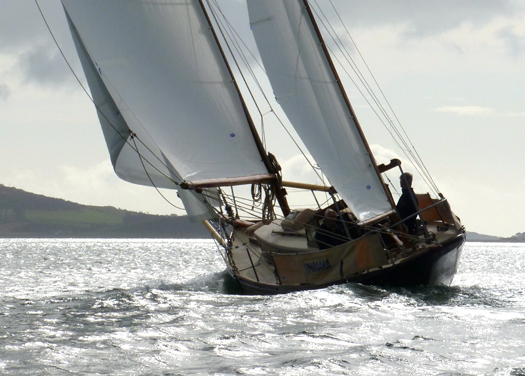
After 94 years, Dickie Gomes's 36ft 1912-built yawl Ainmara (seen here on her home waters of Strangford Lough) hopes to return to defend the title in Howth's Lambay Race, which Ainmara won in 1921 while still in the ownership of her designer-builder John B Kearney. Photo: W M Nixon
The Old Gaffers attention then swings north as the Tall Ships are coming to Belfast from Thursday 2nd July to Sunday 5th July. This is going to be a serious biggie with those ships already signed up including a significant turnout of Class A vessels, which are square riggers and others of more than 40 metres in length. Belfast Lough lends itself particularly well to the Parade of Sail which follows a Tall Ships gathering, and in 2009 when they were last in the port they put in in a virtuoso display with the Dutch ship Europa in particular going to the trouble of getting herself over towards Whiteabbey in the northwest corner of the lough to allow her time get every stitch of sail set before proceeding seawards down-lough in colossal style, a much more impressive display than we've become accustomed to in Dublin, where the shape of Dublin Bay is such that it doesn't really provide the space for square riggers to set all cloth before getting out to sea.
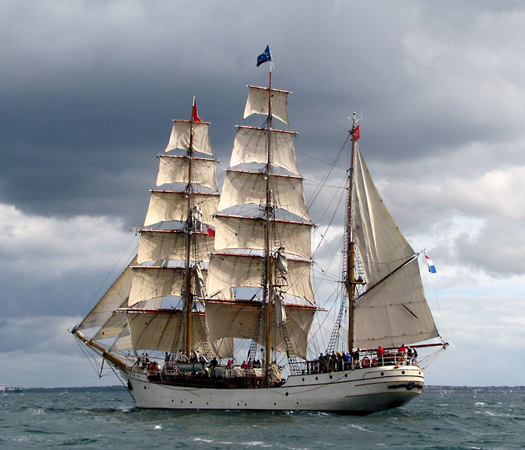
The Tall Ship Europa shows how it should be done in Belfast Lough in 2009, taking time out to set full sail before she starts to gather power to make the proper input into the Parade of Sail.
Like Dublin, Belfast has shown it can be hospitable to Old Gaffers, and it was a very welcoming main port during the OGA Golden Jubilee Cruise-in-Company in 2013, so for 2015 the OGA National President Sean Walsh hopes to up the ante by persuading his members from all round the Irish Sea to gather in Belfast, and to add spice to the mix, he hopes to persuade the Howth 17s to put in an appearance as well, to sail with local one designs like the 1903 Belfast Lough Waverley Class, which have been experiencing a revival in recent years.

Old Gaffers in Belfast for their Golden Jubilee in 2013. The Irish Sea classic and traditional fleet will return to the same venue for the Tall Ships gathering in July 2015. Photo: W M Nixon
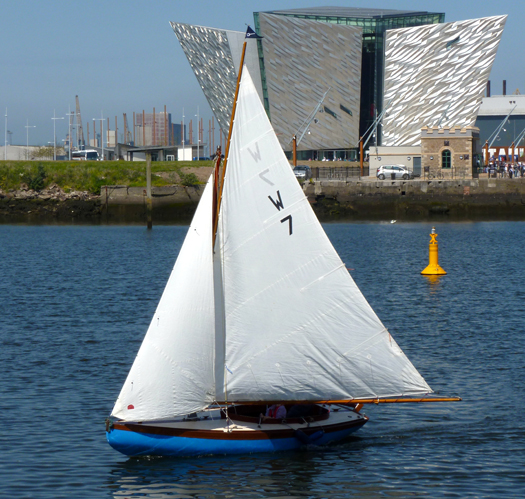
The Belfast Lough Waverley Class Lilias (built 1903) sailing at the Titanic Centre in Belfast. In 2015, the Waverleys will be joined by some of the 117-year-old Howth 17s to participate in the visit of the Tall Ships. Photo: W M Nixon
The Seventeens have made long treks as a class before – in 1998, five of them were road-trailed to Carrickfergus to mark the class's Centenary, with the first five boats built by Hilditch of Carrickfergus. So though they'd trailed there, they then sailed the 90 miles back to Howth, just as the first boats had done a hundred years earlier. Then in July 2003, fifteen of the Seventeens took part in the Glandore Classics Regatta thanks to a brilliantly organised exercise in logistics using a flotilla of low loaders which could take three boats apiece.
For all of Ireland's classic and traditional boats in 2015, and an international fleet too, Glandore is very much up on the radar again, as a special effort is being made by a GHYC team led by Donal Lynch to encourage increased numbers in the CH Marine Glandore Classic Regatta from Saturday July 18th through Friday July 24th. It's a date which certainly allows Old Gaffers plenty of time to get down from Belfast, indeed some may even consider the option of making the voyage northabout to take in a round Ireland cruise while they're at it. And as that great magnet of the Irish Sea classic and traditional scene, the Peel Traditional Boat Weekend, isn't until Friday 31st July to Sunday 2nd August, it's just about possible to factor that in as well.
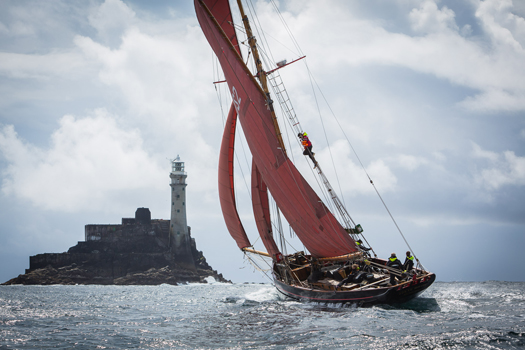
Everything happening at once – the famous Pilot Cutter Jolie Brise was the star of the Glandore Classics in 2013, and as it was her own Centenary she celebrated by sailing round the Fastnet Rock – she has been a successful Fastnet Race participant several times. Photo: Brian Carlin
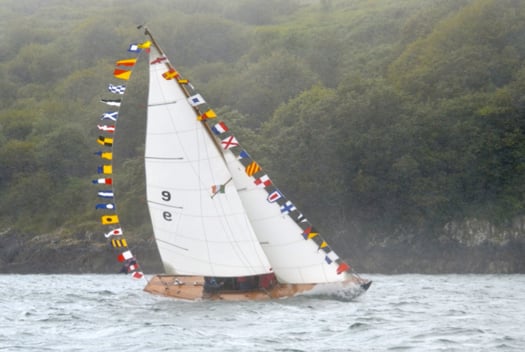
The Glandore Classics attracts an international fleet, and 2013's regatta included a class of Fife One Designs from the Menai Straits, all of them keen to party and showing it. 2015's Glandore Classics is from July 18th to 24th. Photo: Cormac O'Carroll
All this is already happening for the oldies with August barely under way, yet for modern cruiser-racers the potential programme for any keenly-sailed Irish boat is equally complex, attractive and challenging. The season starts as usual with the Scottish Series from Friday 23rd May to Monday 26th May – there'll probably still be snow on the mountains of Arran. They've gone back to their roots by starting with a feeder race from Gourock to the main regatta centre at Tarbert on Loch Fyne. "Going back to the roots" is something of a theme for this year's staging of the Clyde Cruising Club's main racing event, as this is the 40th Scottish Series. Come to think of it, there are so many important 40th anniversaries happening in sailing these days that we have the admit that the decade which brought us the full horror of wide lapels and flared trousers also contributed some lasting elements of the international sailing scene, indeed it could be said that the modern era in sailing really began about forty years ago.
Back in Ireland, the ISORA programme will be well under way by June, while the Lambay Race on June 6th can be looked at with more interest by several boats, as the biennial National YC Dun Laoghaire to Dingle Race doesn't start until Friday June 12th . Last time round, there was a total fixtures clash between the two events, but in times before that hyper-keen sailors such as the Tyrrells of Arklow with Aquelina have been able to fit in both, indeed one year they did it so well they won both too, and were rightly acclaimed as the Afloat "Sailors of the Month" for their success.
For 2015, defending champion in the Dingle Race is Brian O'Sullivan of Tralee with the veteran Oyster 37 Amazing Grace, which came good in the end in 2013 with a new breeze which knocked pending leader Antix (Anthony O'Leary) off the winning perch. But with the 2015 Dingle Race acting as a useful if rather indirect feeder for the Covestone Asset Management Sovereigns Cup in Kinsale from June 24th to 28th, there could be all sorts of sharp boats lining up to take the prize, for the Sovereigns Cup 2015 includes the all-singing all-dancing ICRA Nats 2015.

The welcoming port – Kinsale is one of Ireland's most popular destinations, and in 2015 its hosts the combined Sovereigns /ICRA Nationals from June 24th to 28th.

Perfect sailing – racing in the Sovereigns at Kinsale in June 2013. Photo: Bob Bateman
Yet the timing of the combined Sovereigns/ICRA Nats is such that there's still plenty of time and space to get back to the Irish Sea for the Volvo Dun Laoghaire Regatta 2015 from July 9th to 12th, a reminder that much of the cruiser-racer programme for 2015 is in a neatly balanced and user-friendly timescale for everyone except perhaps those who wish to do either the entire ISORA or SCORA programme as well, so the problem mostly is going to be getting time off work.
And for the hyper-keen cruiser-racers, particularly those whose boats are small enough to be conveniently trailerable, further temptation looms in 2015 with the WIORA Championship at Galway Bay Sailing Club from July 22nd to 25th. For the fleets in the Shannon, on Tralee Bay, and in Clew Bay, it's a bit more than a day's sail away, but they'll be there to challenge Liam Byrne of the home club who won it in 2014 with his Corby 25 Tribal at Mayo SC in Clew Bay, while some top boats from more distant centres are expecting to trail to Galway Bay to spice up the competition.
By this stage of the season a more relaxed pace might be welcome, but the lively turnout of 80 boats in 2014 for the new-style four day Cork Dry Gin Calves Week out of Schull in early August (Tuesday 4th to Friday 7th August in 2015) suggests that for racing sailors, the best relaxation is more racing, but in a holiday setting. And yes, it has been noted that a true West Corkian sailing nut could indeed do all of Calves Week 2015, and still be on the Squadron line for the start of the Fasnet Race nine days later.
For dinghies in 2015, the big story is the debut of the newest version of the National 18, and just how popular will the Bray-bult foiling Moths become, while established classes will frame their programmes to accommodate sailors whose time is limited, also having to fit in with a national scene where the number of Race Officers with the necessary skills is inevitably a finite amount.
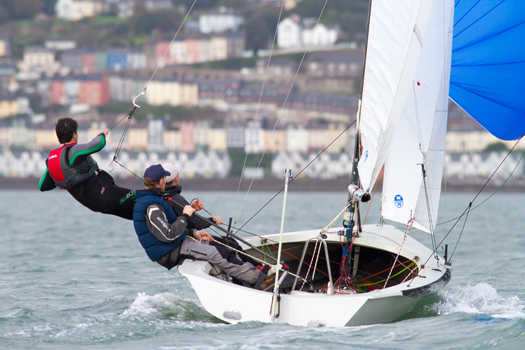
The big stories in Irish dinghy racing in 2015 will be the arrival of the new National 18s at Crosshaven, and the revival of Dinghy Week there in late August. Here, in the Autumn of 2013, To Dwyer and Nin O'Leary test sail the prototype of the new 18 on Cork Harbour. Photo: Bob Bateman
The new Third Generation (or maybe it's fourth or fifth generation) National 18 may have been designed in England by Phil Morrison, and is being built there too. But it was the very active Crosshaven fleet with the Royal Cork Yacht Club which led the charge towards a new boat, and when it came to stepping up to the plate to pay twelve substantial new boat deposits to move it all along after the prototype had been rigorously tested in Cork harbour last Autumn, it was the Crosshaven fleet that provided eight out of those twelve cheques.
So it's entirely appropriate that in August 2015, the dinghy focus will swing big time towards Crosshaven and a short form "Dinghy Week" from August 21st to 23rd. The old style Irish Dinghy Weeks – the last one was in 1970 – became victims of their own success, they just got too large. But the different classes became over-optimistic about their continuing individual growth prospects. Then the pendulum swung too far the other way, and dinghy classes were alone and their events shrinking. But a resurgence of club and championship dinghy sailing in Crosshaven during 2014, and a growing realization that over-reliance on single-handed dinghy classes does not necessarily produce a socially-adjusted national squad of junior sailors, resulted in some clear and creative thinking about developing two-handed boats, and reviving some old classes such as the Mirrors.
The form of this new Dinghy Week is still in the melting pot, but at least eight classes have responded with enthusiasm. Meanwhile, the National 18s in Crosshaven will be such a focus of interest during 2015 with the first of the new boats making their debut that we'll have a season-long dinghy narrative developing on Cork Harbour, and the revived Dinghy Week will be just part of it.
As for inshore keelboats, the big one in terms of number is the combined British and Irish Championship Squib Championship at Howth from 27th June to 3rd July. The handy little Squibs are something of an oddity, as they serve so well as a cherished local class in so many Irish sailing centres that many owners see them as that, and nothing more – handy little club sailors to be raced on home waters a couple of times a week.
This means that when a major regional or national event is held, the number taking part will often only be a fraction of the total Irish Squib fleet. But for those who do make the trek, the competition is fierce and the racing great – in Howth, the high point was in 1996, when this "Nationals" event attracted a fleet of exactly a hundred boats, and on one never-to-be-forgotten morning, there they were, every last one of them on the starting line.

A hundred Squibs all in a row at Howth on Tuesday July 25th 1996. Photo: Mandy Murnane
The most recent Squib event of national stature was the Freshwater Keelboat Regatta at Dromineer on Lough Derg on the weekend of October 18th-19th, and the battle for the top places was between the Kinsale and Belfast Lough fleets, with James Matthews and Rob Jacob of Kinsale rounding out their year in style with a good win.
But with the Squibs in England undergoing a revival – they were the second-biggest One Design fleet in Cowes Week 2014, bested only by the legendary XODs – there's no doubt there's a strong challenge coming across channel, and any Irish boat getting into the top ten will be doing well.
As for that annual Autumn Freshwater Keelboat Regatta at Dromineer, while it may have been much hampered by the spinoff from some ferocious weather out in the Atlantic with frustration for some of the sixty boats hoping to take part, it's an event of enormous potential, and the many who wish it well and have enjoyed it in the past will be ready and willing to do their part to make 2015's regatta a success.

The Squibs enjoying a lull in the strong winds during the Lough Derg Freshwater Regatta 2014. Overall winner was Mucky Duck (no 51, James Matthews & Rob Jacob, Kinsale YC). Photo: Gareth Craig
All these specialised and localized events planned for 2015 will be the continuing background music to the usual events of national sailing focus, everything from the selection of the Irish team for the Student Yachting Worlds to the Helmsmans Championships to the steady increase in pace while 2015 develops as the pre-Olympic year. As the year rolls along, other stories will develop too. So perhaps it's appropriate that we exit this review as we entered it. Just pause to remember now and again that, a hundred years ago, you simply couldn't have gone freely afloat like this for sport and recreation at all.
But we can't close on such a solemn note. Seasoned Solent sailors may have noted our header photo from Guido Cantini at the Panerai Classics Regatta was looking just slightly odd, for some reason difficult to pin down. Well, as it happens, the photo was sent to us back in September just as we were contemplating the excellent cleanup up done by Jason Hurley of Jason Hurley Design on the Mercedes-sponsored billboard photo of Howth 17s on the end wall of Howth Yacht Club. As with many photos taken over the RYS starting cannons, the Cantini pic included an obtrusive part of the Fawley Oil Refinery across on what Isle of Wight people call "the north island". Though Fawley has been there for yonks, it still has the look of a temporary structure. So we got Jason to treat as just that. But here for your edification is the true picture. You could get a taste for this sort of thing. What about brushing out Whitegate, lads? And as for Milford Haven.........
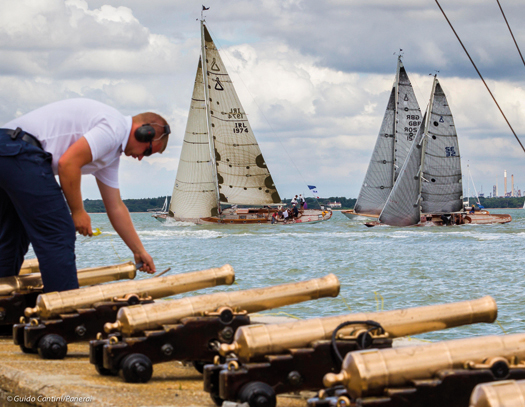
The unvarnished truth. In real life, the view from the RYS battery at Cowes can be slightly marred by the clutter of Fawley Refinery across the Solent on "the north island". Photo: Guido Cantini/Panerai
Read also: 2015 Irish Sailing Fixtures List (provisional)
Titanic Emotions
#oga50 – There's a nasty old quip which defines mixed feelings as the emotions you experience while watching your mother-in-law drive your new Beemer over a cliff. Quite. But if you want to experience mixed feelings in a more socially acceptable way, try a visit to the Titanic Quarter in Belfast which, in its waterfront areas at least, manages to serve up high-speed mood swings whichever way you turn. Or so it seems to those of us who grew up in a sort of Titanic Disaster Denial environment.
There were many families in the greater Belfast area with an involvement at some level in the city's large and varied engineering industry. My mother's family was one of them. These clans took the loss of the Titanic to heart. It simply wasn't discussed in the family home. And if a stranger did happen to mention the T-word, the matter would be dismissed with a curt remark about there being seventeen other ships under construction in Belfast in 1912, and the loss of the Titanic was only a blip in the onward march of a great industrial port.
These days, things have lightened up a bit with the droll Belfast response that the ship was okay when she left Ulster. But then the pot is stirred again by the likes of Billy Connolly with his question as to what the Catholics of Belfast were doing when the Protestants were building the Titanic. The answer is they were building an iceberg.
For Belfast the feeling was that, as far as the fate of the Titanic was concerned, they wanted to move on. It was the rest of the world which was like an old dog with a bone, worrying away at a bit of receding history. But alas, the dog got younger, and the bone got juicier. And it was one of their own, Northern Ireland-born film producer William MacQuitty, who revived the story with an excellent movie which he called A Night to Remember, a double-edged title in light of Belfast's hidden wish to be allowed to forget.
After that, it was open season, culminating in James Cameron's special-effects-laden Hollywood blockbuster, made when blockbusters still made money. With the Centenary approaching in 2012, and Belfast needing investment in some visionary project to revive the moribund shipyard area where ship-building had ceased a decade earlier, there was nothing for it but to go with the flow, and go for it wholeheartedly. And now, with the extraordinary Titanic Belfast centre dominating the east bank of the River Lagan, they have a visitor attraction which, in terms of numbers crossing the threshold, is rivalled in the Irish context only by the Guinness Storehouse in Dublin.

The new Titanic Centre is at its most impressive at night Photo: W M Nixon
With the Titanic Belfast centre have come other consumer-friendly amenities, such as the new Belfast Harbour Marina. It's still in a fairly raw state, with Portaloos rather than a shower block, while finger pontoons have yet to be installed in the inner section. But that means there are many metres of clear walkway which provide easy berthing for slow-manoeuvring old gaffers of all sizes, so the OGA 50 Round Britain cruise-in-company descended on it last weekend big time.
Last week, we were discussing the reality that bowsprits are marina managers' nightmares, and were soon emailed the helpful info that in the trade, bowsprits are known as dock probes. Moreover, your dyed-in-the-wool old gaffer will think it an affront when marina staff try to charge him or her for berthing fees for the bowsprit. Indeed, a genuine old gaffer will think that, as the boat brings so much character and interest to an otherwise bland modern yacht harbour, not only should the management abandon any notion of being paid for the bowsprit, but as a gesture of goodwill and welcome, they should knock a metre or two off the length of the boat's hull for billing purposes.
Ideally, in fact, they should charge the Old Gaffers nothing at all. That's what Belfast was doing last weekend, so a very varied fleet was in the marina in the final burst of hyper-sunshine. And as the marina is in the Abercorn Basin, for those of us reared in the Belfast nautical tradition, it was just too good to resist, for the Abercorn Basin was the starting point for the epic cruise of the Calabar.
"The Cruise of the Calabar" is a cod-Irish ballad in that classic late Victorian style which is decidedly patronizing. But it's not the worst, so we'll tag it on at the end so that those of you who can't stand such things can make a timely exit. Meanwhile in Belfast we were fairly wallowing in nostalgia, with the OGA50 visit off the launching pad with a reception in the Harbour Commission Offices, which the blurb told us is an impressive 150-year-old ornate Italian-style palazzo.
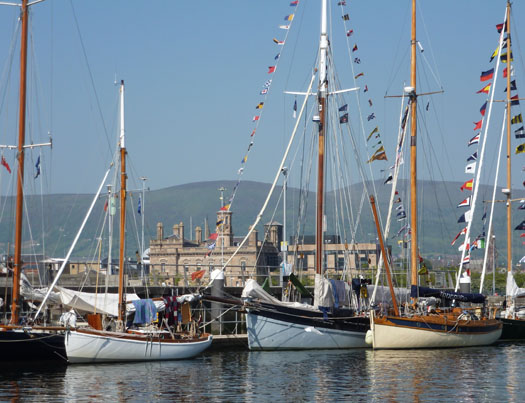
The Belfast Harbour office seen beyond Raven from the Netherlands, the pilot cutter Annabel-J, and the Heard 33 Toucando.
Photo: W M Nixon
Despite having spent some weeks in this palazzo during some work experience between school and college a very long time ago, I hadn't really registered its specially exuberant style, perhaps because Belfast – notwithstanding its being a very Presbyterian city – had acquired a remarkable number of Italianate buildings during its period of mega-growth in the latter half of the 19th Century. The place was up to its tonsils in Italianate buildings, and you could soon have enough of them. Then too, I was allocated to the engineers department, which was in a more workmanlike part of the building.
There, our day was punctuated each morning at precisely 10.30 by the determined squeak of the Harbour Engineer's shiny brown brogues as he strode purposefully down the corridor, resplendent in his immaculate tweed suit and with all the burly presence of a former rugby international, marching out the huge front door and straight across Corporation Square to the nearest bar, where he would down his first large whiskey of the day exactly a minute after opening time.
While the main parts of the Harbour Office may have been palatial, beneath it there was a warren of cellars where many of the rooms had been tastefully adjusted by the senior engineering staff for their own personal comfort. Long before the post-prandial power nap became recognized as an essential part of life for top executives, the senior engineers of Belfast harbour were practising it in their subterranean boudoirs, and it wasn't unknown for some of them to overnight for a few days when the nagging of their wives became intolerable.
As to being an intern in harbour engineering, all I can remember is that it was in the early days of echo sounders, and my work experience consisted in trundling off to some remote corner of the harbour in one of the well-appointed launches with a couple of dry-humoured engineers to spend some time discovering that the new echo sounder was on the blink yet again, and then heading back to base in order to be in the office for close of work.
These days, of course, the pace of work in Belfast Harbour engineers department is much more hectic, and only this week it was announced that they're about to build Ireland's first proper terminal to berth cruise liners. But it was a boat at the other end of the size scale which took pride of place among the Old Gaffers in the Abercorn Basin last Saturday, for there, sailing about as easy as you please, was Lilias, a restored Waverley class sloop.
The Waverleys are the quintessential Belfast Lough class. While the area's many upwardly mobile yachtsmen around 1900 were turning to the likes of Fife and Mylne and Linton Hope to design their burgeoning new One Design boats, down at Whitehead at the seaward end of the northern shore of the lough, the members of the very local if grandly named County Antrim Yacht Club were turning to one of their own, John Wylie, for the design of an 18ft keelboat which would be affordable, robust enough to cope with Whitehead's very exposed anchorage, and small enough to store in the boathouse.
Wylie was the technician in the laboratory of the Physics Department in Belfast's Queens University, and his work there was so highly regarded that, when he retired, they awarded him an honorary degree. As an amateur boat designer, his output was very small, but with the Waverley he hit the target spot on. At first glance, you'd think they're one of the Solent's famous X One Designs with the after end cut down from a sawn-off counter to a transom stern. But in fact the Waverley well pre-dated the X Boats of 1911, so these little Belfast Lough 18-foot keelboats are sui generis.
Little is the operative word – in size they're midway between a Mermaid and a Squib. Yet thanks to a full-bodied yet surprisingly fast hull, they can accommodate a reasonable cockpit with bench seats each side, making them much more comfortable to sail than, say, a Howth 17.
The first three boat were sailing off Whitehead by 1903. Initially the builder was the great Belfast backstreet boatbuilder Paddy McKeown, who couldn't read or write, but was a genius at interpreting boat plans. The class was soon popular, and they'd dozens of attractive boat names to draw on, as all were named after characters in Scott's Waverley novels. By 1906 Lilias was among those from McKeown joining the fleet. Once the boats went to Whitehead, they seldom if ever returned to the yard, so when Jeff and Janet Gouk brought their lovingly restored little boat into the Abercorn Basin from Bangor eight days ago, it was quite possibly the first time she'd been back in Belfast in 107 years.
The class is now only extant - and in a very limited way at that - in Bangor. Unfortunately, while the harbour there has a first class marina, there are no swinging moorings, which are important for supporting little old local one design classes. But despite the problems of getting in and out of their berth, people still love to sail Waverleys, and last year Lilias rounded out the season by being winner of the Lufra Cup, Ballyholme's time-honoured come-all-ye pursuit race.
In their heyday the class had strong fleets at both Whitehead, and Ballyholme across the lough, with very healthy inter-club rivalry. Inevitably the increasing popularity of bermudan rig brought friction. John Wylie would have nothing to do with it, so in 1935 some owners commissioned the designs for a Bermudan rig from Alfred Mylne in Glasgow. World War II interrupted the movement for a changeover, but when my uncle bought the Waverley Montrose (no 13) in 1945, he changed her to bermuda rig the following Spring.

The Waverley Class Montrose as she was in 1945 at Ballyholme, still carrying original gunter rig
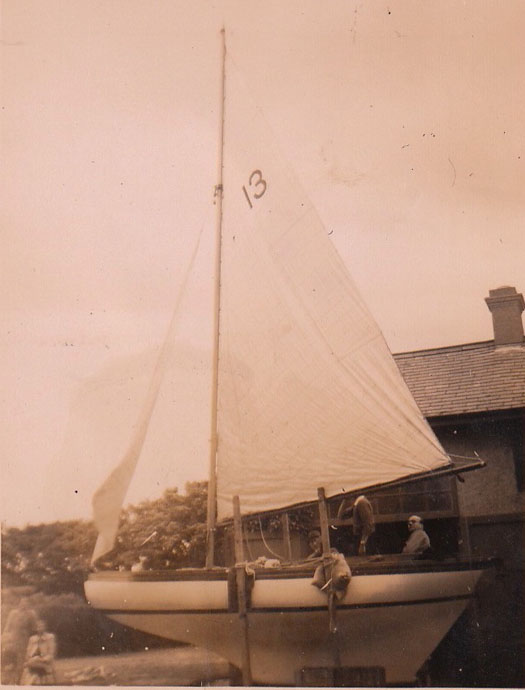
Montrose with a dry land trial for her controversial new Bermuda rig in the Spring of 1946.
My father sailed with him, and the two of them were like a pair of schoolboys, so impatient to see the new rig they put it up in the yard at home. Soon my father had his own Waverley, Rowena (no 1), and as she was already Bermuda rig, between the two boats there was quite a bit of success, especially in light breezes. Yet still other boats stuck with the original gunter rig, claiming that the only true Waverley was a gunter-rigged one, and disdaining the success of the Bermuda boats. So at the class AGM in April 1948, my uncle proposed and my father seconded a motion that all Bermuda boats revert to gunter rig. It sounds very sporting. But it was mischief-making typical of the two brothers-in-law - in a month's time, they were taking delivery of their new co-owned 25ft Glen One Design and exiting the Waverleys, leaving their former classmates with this contentious proposal simmering on the back burner for years.
It arose again in 1950 when the Bermuda-rigged Waverley Fair Maid foundered in a sudden gale while crossing Belfast Lough from Ballyholme back to Whitehead, with the loss of four lives. The class at Whitehead never really recovered from this tragic setback, and many lost faith in the gallant little boats. But then in 1961 brothers Kevin and Colm McLaverty, with Mick Clark as third hand, cruised round Ireland in handsome style from Carrickfergus with the Bermuda-rigged Waverley Durward, and the design resumed its rightful place of respect as a remarkably able little boat.
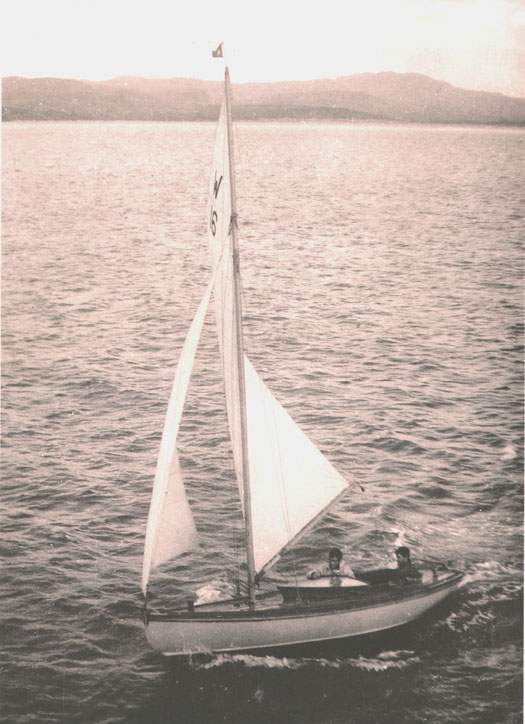
Durward at Sheephaven in Donegal during her round Ireland cruise in 1961. Photo: Kevin McLaverty
However, the class weren't finished with misfortune. By 1976, it was undergoing a new lease of life, with 13 boats all at Ballyholme, and all carrying gunter rig. But while Ballyholme Bay is a good passage anchorage in offshore winds, and a great place to sail, it's much too exposed for moorings. Yet in those days there was nowhere else in Bangor to keep a boat, and in September 1976 the Waverleys paid the price in a storm force northerly. The lucky boats were those that sank – they survived with only partial damage on the seabed. But those that were driven ashore became matchwood. And of the only two still floating, one sank the final inch while they were putting pumps aboard in the post-storm calm.
Yet the spirit of the Waverleys lived on, and by their Centenary in 2002-3, they were sailing as a class again. So the chance to sail aboard Lilias with Jeff Gouk – the first time for me in a Waverley since crossing the North Channel in Durward in 1961 - was top priority in Belfast, and every moment was pure joy. They're absolute honeys to sail, with good ergonomics, lovely handling, and everything as light as a feather.
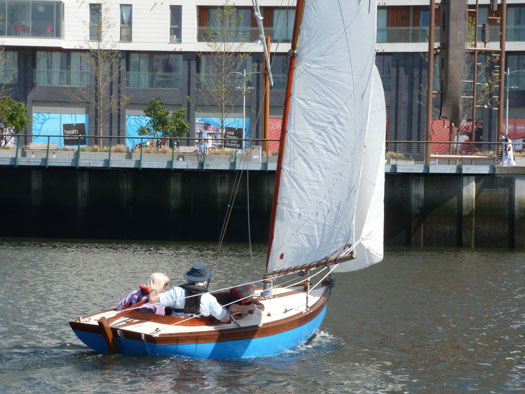
Lilias is all of a piece, a beautifully restored little sloop. Photo: W M Nixon
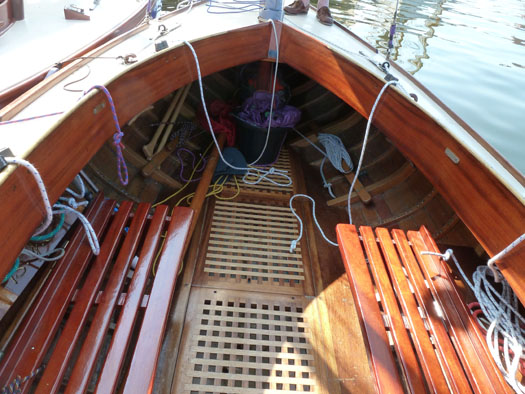
The cockpit on Lilias is much more comfortable than on many craft of similar size. Photo: W M Nixon
And there was new interest in the OGA 50 fleet, as Adrian "Stu" Spence's 1875-built Pilot Cutter Madcap had joined up, as had Isabel Hood's 1894-built Glance. There's one thing which all the old gaffer boats have in common. They're likable boats, every last one of them, and clearly their owners love them dearly. Thus with Madcap, the accommodation is so sensible and friendly, it could usefully be transposed to many modern boats. And as for Glance, that gallant old veteran which was already 61 years old when she won the Jolie Brise Cup for the Hopkirk brothers of Belfast in the 1953 Fastnet, she simply exudes good vibes on deck and below.
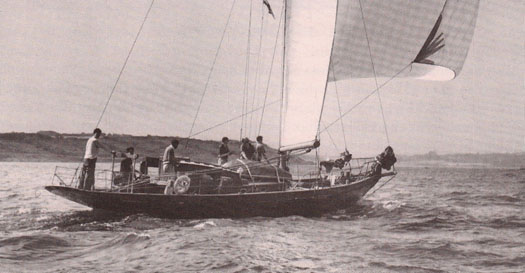
The 1894-built Glance on her way to winning the Jolie Brise Cup in the 1953 Fastnet.

Glance's attractive accommodation works well both at sea and in port. Photo: W M Nixon

The pilot cutter Annabel-J made for an ideal party boat Photo: W M Nixon
The Belfast visit was very much a voyage across the seaways of memory, and we made a point of heading for Tedford's seafood resturant on Donegal Quay for dinner after a fine old party aboard the big pilot cutter Annabel-J. In days of yore, Tedford's was the chandlers and sailmakers which were the first port of call in Belfast for any impecunious young skipper when fitting out. They carried an enormous stock, they would try to do things to old sails that no other sailmaker would contemplate, and they were very kind in extending credit until Christmas when there was a faint hope some kind aunt might see her way to a sensible cash gift.
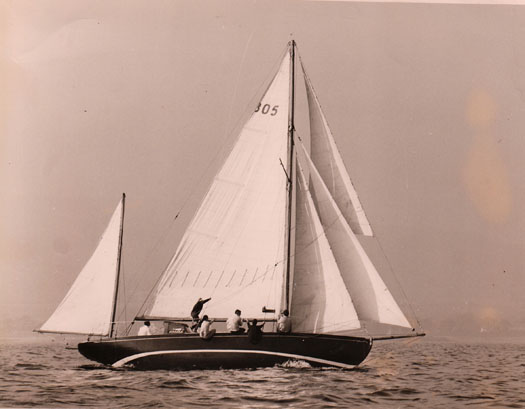
Ainmara with her "new" mainsail in 1967, re-cut from Griffin II's former sail with maximum economy by Billy the Twitch of Tedford's. Photo: Denis Pogson
It was a place of character and characters, whether it was Jimmy with his eternal duncher cap, I suppose you'd call him the sales executive, or Billy the Twitch, who was the sailmaker. Billy finally gave in to Dickie Gomes' persuasive powers and reduced the large second-hand mainsail somehow acquired from the RORC Club Yacht Griffin II into Ainmara's first terylene mainsail in 1967. It was such an economy job that he simply left half the sail number on the new leech. Though very heavy, it was an excellent sail, living testimony to Tedford's skill and tolerance

Tedford's classic and unchanged exterior today, with (left to right) Ed Wheeler, Dickie Gomes and Brian Law. But within, there isn't a trace of the old place as they knew it in the 1960s. Photo: W M Nixon
Anway, we dandered along to Tedford's in the velvet warmth of the summer evening, and it was reassuringly exactly the same outside. But inside, though the seafood is really good, there's not one single artefact or picture to remind you that this used to be a chandlery and sailmaker so perfect it was like a stage set. Instead, you've just another 21st Century restaurant.
So the meal was fine, but we felt a little cheated. But the next item on the agenda was the real McCoy, the first function to be held aboard the newly-restored Nomadic, which was the tender ship which took the passengers from Cherbourg out to the Titanic in April 1912. Superbly organized by Alan and Irene Aston of the Belfast OGA, this party was mixed feelings with turbo-power. You don't need much imagination to visualise the passengers of 1912 crowding the little ferry ship. You don't need any imagination – the Nomadic is crammed with ghosts.

The haunted ship. The Nomadic is crammed with ghosts. Photo: W M Nixon
And outside, glowing in the night, was the astonishing Titanic building. We'd a special link to this, as its remarkable exterior surface was designed was created by Alan Grimason. Back in the day, "Grim" (he's anything but) was an early crewman on Ainmara, and he was the man to call on for name-painting on boats at the right price. We still have the boats being run if at all possible at the right price, but with his Titanic building Alan has moved on – it's remarkable in daylight, at night it's astonishing.
On Sunday morning, boats were already moving on towards Scotland. But for the many who stayed, there was a river-cruise up the Lagan for a very good barbecue at the new pub at Cutter's Wharf. They were to have yet another party on a barge in the city that night, but several of us took our farewell from the OGA50 rolling circumnavigation at Cutter's Wharf. And where better? For we had just re-lived the Cruise of the Calabar:
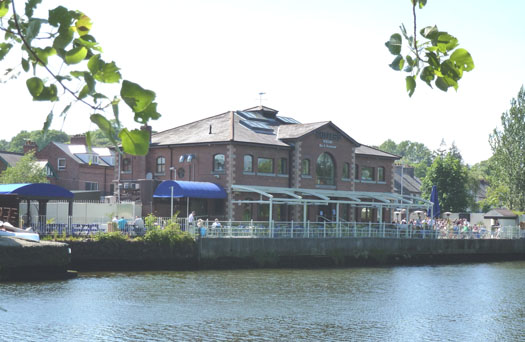
Destination for a 21st Century Cruise of the Calabar – Cutter's Wharf on the River Lagan at Stranmillis in south Belfast.
Photo: W M Nixon
The Cruise of the Calabar
Come all ye dry-land sail-y-ors and listen to my song,
"Tis only forty verses, so I won't detain yous long,
It's all about the voyagings of this old Lisburn tar
Who sailed as man afore the mast aboard the Calabar.
Now the Calabar was a spanking craft, copper-fastened fore and aft,
Her helm it stuck out far behind, and her wheel a great big shaft,
With half a gale to swell each sail, she'd make one lock per hour,
She's the fastest craft on the Lagan canal, and only one horse-power.
The Captain was a strappin' lad, he stood full four foot two,
His eyes was black, his nose was red, his cheeks a Prussian blue,
He wore a leather med-i-al that he won at the Crimea war,
And his wife was steward and passengers' cook aboard the Calabar.
"Come here me lad" the captain says, "come here" says he to me,
"Would you like to be a sail-y-or and roam the raging sea?
Would you like to be a sail-y-or the foreign seas to roll
For we're under orders for Portadown, with half a ton of coal."
We left the Abercorn Bas-i-on, the weather it being sublime,
And passing through the old Queen's bridge we heard the "Albert" chime.
'Tis then we came to the Gasworks Straight, a very dangerous part,
And ran head on to a lump of coal that wasn't marked on the chart.
Then all became confus-i-on, the stormy winds did blow,
The mate slipped up on an orange peel and fell into the hold below,
The captain called for much more steam, for we were sorely pressed,
But the engineer from the shore replied, "The oul horse is doing his best."
Next morning when we wak-i-oned, we was in a terrible funk,
The mate he had been drownded dead while sleeping in his bunk,
To save the ship from sink-i-ing, and to save each precious life,
We threw the cargo overboard, along with the captain's wife.
A farmer going to his work did hear our piteous roar,
He threw us the end of his galluses, and pulled us to the shore.
I'm done with ocean rambl-y-in', and roamin' the ragin' main,
And the next time I go to Portadown, I'll go there by the train.
Good Old Gaffers in Dublin Bay
#oga50 – It's not the boats that are the marina manager's nightmare. It's the bowsprits. That said, the boats themselves, with their long old keels and huge propellor apertures, or even with funny little props set under the quarter – these boats can be problematic. With configurations like this, you can bet for sure they can be awkward enough to manoeuvre. And handling them in confined spaces, you need a masters degree in prop crawl.
Yet that is still something to which normal boaties can relate. But then you throw in a bowsprit as big as a telegraph pole, pointing into everywhere it isn't wanted like a snouty mongrel, then you really do have a problem in a confined harbour normally used by shiny little boats that can spin in their own length, and stop within seconds of engaging in astern.
All of which goes to explain why the Old Gaffers Association, celebrating its Golden Jubilee with a Round Britain challenge with a couple of diversions to Ireland, has tended to focus on major ports with long pontoons and longer quays for its main gatherings. In Britain the festivities are sponsored by Associated British Ports, while in Ireland it has been Dublin Port and Belfast Harbour who have put out the welcome mats. So the fleet came to Dublin Bay from May 31st to June 4th to be hosted by the Dublin Bay Old Gaffers Associations through the generous hospitality of Poolbeg Yacht & Boat Club, and Dublin Port gave it all a fine fair wind.
The Old Gaffers Association was founded at Heybridge Basin beside the characterful little port of Maldon in Essex in 1963 to "preserve interest in, and encourage development of Gaff Rig, and to participate in the maintenance of our maritime heritage". Over the years, as some good Bermudan rig boats have matured, the gaff-rig-only line has been softened to include them, and the membership now even includes people with plastic boats.
The Golden Jubilee cruise – a season-long rolling event, with boats joining and leaving as they please - got under way from Maldon on April 21st 2013 in a very modest sort of way with just three boats initially participating, and only two of them – the 1898-built 31ft cutter Witch (Alistair Randall, originally built as the ferry to Gigha in Scotland) and the ferro-cement gaff-rigged take on a John Hannah design of 1924, the 37ft Bonify (Sue Lewis & Howard Wheelton) – planning to go the whole way round.

Bonify (red hull) is one of the two boats which started the complete circuit from Essex rolling on April 21st. She is seen here at Poolbeg Y & BC as the Howth 17s start to arrive in port on Saturday June 1st. Photo: W M Nixon
But in their charm and individuality, Witch and Bonify symbolize the eclectic nature of the Old Gaffers Association, which cheerfully embraces all the odd old boats and eccentric owners that other organisations don't reach. And in their progress round the southeast of England, they were soon linking up with a a strong Dutch contingent which included craft as diverse as Rik Janssen's mighty Galway Hooker Cine Mara (superbly built in steel) and F J Schotman's exquisite little Lyle Hess-designed 28-footer Raven.
Gradually the fleet increased as the OGA50 made its way down the English Channel. But the vile weather of May hampered their progress, and few made it to a planned meet in the Isles of Scilly. However, despite headwinds a core group got round Land's End and across to Milford Haven, their numbers by now including 73-year-old Barbara Runnalls from Sussex gallantly sailing alone on the 23ft gaff cutter Moon River.
After days of adverse northerly gales in Milford Haven, the end of May finally signalled the start of something approaching summer, and they went north to Holyhead and a warm welcome from the local branch of the OGA. There too was Joe Pennington who had earlier sailed down from the Isle of Man singlehanded in his handsome big traditional cutter Master Frank, the only surviving Manx longline sailing fishing boat. On being congratulated on his achievement, Joe replied that when you've a Force 8 up your tail, there's no turning back...
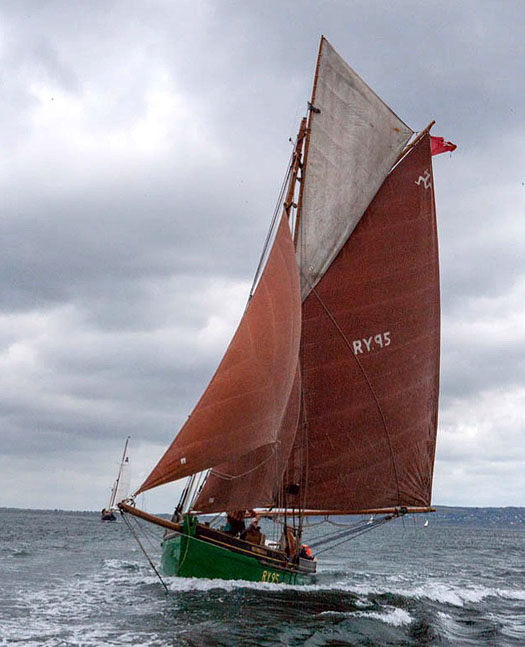
The Manx fishing boat Master Frank was sailed single-handed by Joe Pennington from Peel to Holyhead in a northerly gale to join the OGA50 Photo: Barry O'Loughlin
Through the last week of May, boats were converging on Dublin Bay from all corners of the Irish Sea, and in Howth the 115-year old classics of the Howth 17 class were in a flurry of activity to overcome the delays in re-fitting caused by the exceptionally cold Spring, as they were to race in the River Liffey between the bridges in the heart of Dublin on Sunday June 2nd as part of the maritime festival which would be a highlight of the OGA's visit.
The Howth fleet were joined on Thursday May 30th by the 36ft 1912-built yawl Ainmara (Dickie Gomes, Strangford Lough) which had scampered down from Strangford in a nor'wester which, downwind of the Mountains of Mourne, had been at the top end of Force 7. The old lady was on a busy programme, as she was designed and built by the great John B Kearney at Ringsnend in Dublin in 1912, and would be re-visiting her birthplace of 101 years ago for the first time in 90 years.
But during the time John Kearney owned her from 1912 to 1923, Ainmara had been overall winner of Howth's famous annual Lambay Race in 1921, so this had to be celebrated at Howth Yacht Club with an onboard party which had the old yawl well down on her marks. By the time it was over, Dickie Gomes had been assured by the Flag Officers that if he could see his way to staying on for this year's Lambay Race (it's on today), then HYC would make sure Ainmara won it again. But alas, as Ainmara was built in the same year as the Titanic but has survived rather better, this weekend she's berthed in Belfast at the Titanic Centre to play a central role in the OGA's visit to the northern port.

The 101 year old Ainmara in Howth on May 30th to recall her overall win in the 1921 Lambay Race Photo: W M Nixon
Meanwhile, back around Dublin Bay, she still wasn't allowed to go straight home to Ringsend, as John Kearney's latter days from 1946 to 1967 saw him as an honoured Rear Commodore of the National YC in Dun Laoghaire. So on Friday May 31st under full sail to jib topsail, she progressed across Dublin Bay helmed by Pierce Purcell of Galway, whose late father was Commodore of the National YC from 1946 to 1948, when he owned the very attractive 35ft Kearney yawl Sonia.
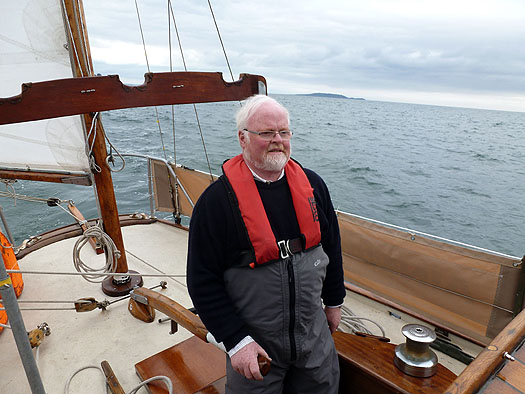
Pierce Purcell of Galway at Ainmara's helm in Dublin Bay – he crossed Ireland for the opportunity to sail a Kearney boat like his father used to own. Photo: W M Nixon
Sonia is now in Canada, but helming Ainmara across Dublin Bay was the next best thing. The Galway man brought Ainmara to the Dun Laoghaire harbourmouth nicely on time to be met by two of the Dublin Bay Mermaids (designed by John Kearney in 1932), which escorted the old yawl to the visitors berth at the National YC where Commodore Paul Barrington headed up his members in a welcome which was superb even by the National's notably high standards, with the club flagpole dressed overall and the signal JBK on the staff.
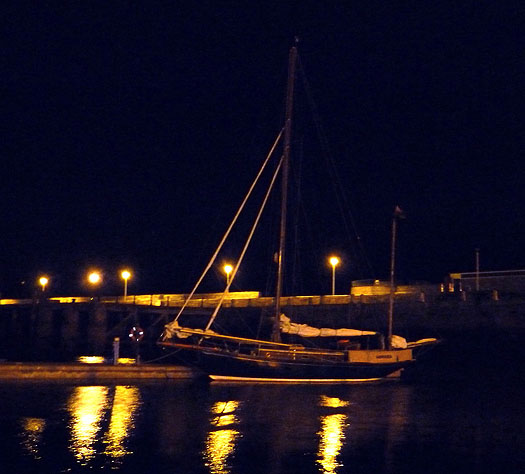
"The old lady is ready to race". Ainmara poised at the pontoon at the National while her welcome party proceeds apace in the clubhouse. Photo: W M Nixon
The first sailing highpoint in the OGA visit to Dublin was to be a race on Saturday June 1st for the RMS Leinster Plate, newly presented by the Communication Workers Union to honour all those who were lost when the mailboat Leinster was sunk by German torpedoes at the Kish Lighthouse in the final months of World War I, and in particular the 21 postal workers who died in the ship's mail sorting room. The plan was to have a race which would retrace at least part of the Leinster's fateful route towards the Kish from Dun Laoghaire, but Race Officer John Alvey of Poolbeg Y & BC couldn't finalise the course for guaranteed finish at a reasonable time in mid-afternoon until early Saturday morning.
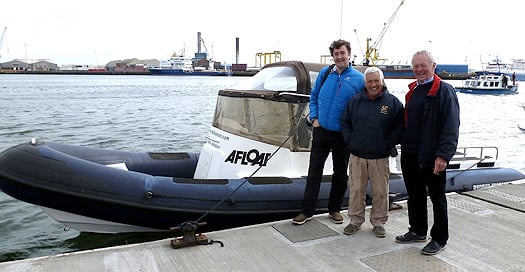
It's the only way to fly. Afloat's David O'Brien with Dickie Gomes and crewman Brian Law after he'd conveyed them at record speed to the early morning Skippers' Briefing at Poolbeg Y & BC Photo: W M Nixon
So the Skippers' Briefing was at Poolbeg at 0800 hrs, with race start scheduled for Scotsmans Bay at 1100. This could have presented a logistics problem for Ainmara's crew already berthed in Dun Laoghaire, but fortunately nice Mr O'Brien from Afloat.ie turned up in the early morning with his fine Red Bay RIB, and they were delivered to the briefing and back again at speeds well north of 30 knots, also enjoying the first of many fine breakfasts supplied by Kate and her excellent catering team at Poolbeg.

DBOGA Hon. Sec. Sean Walsh's heard 28 Tir na nOg had a good weekend of it, with a third on the Saturday and a first on Monday. Photo: Barry O'Loughlin
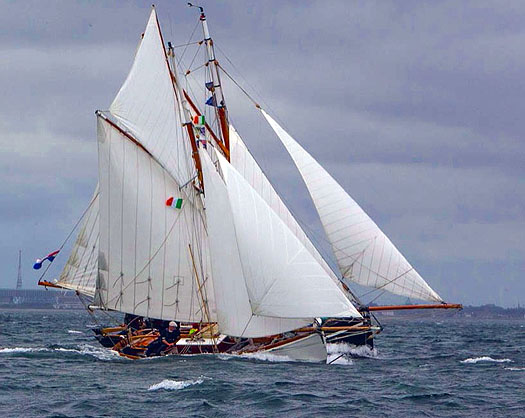
The Lyle Hess 28 Raven from The Netherlands had a fine race on Saturday, finishing second overall. Photo: Barry O'Loughlin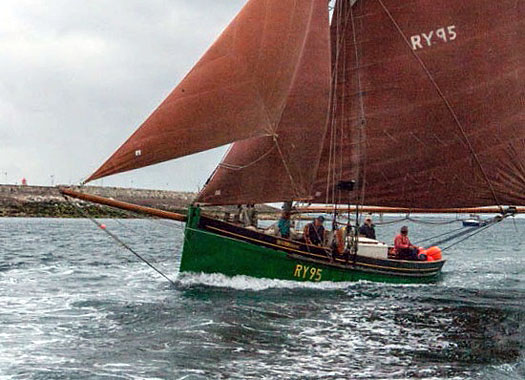
Master Frank (Joe Pennington) was to lead at the North Burford Photo: Barry O'Loughlin
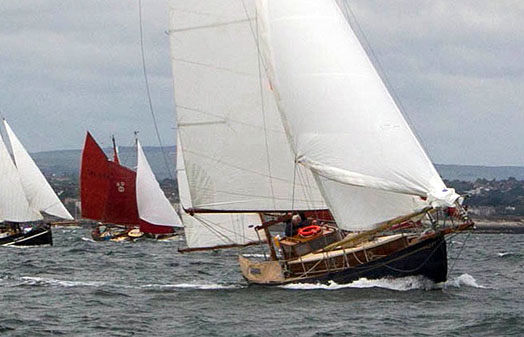
Ainmara starting to emerge from the pack Photo: Barry O'Loughlin
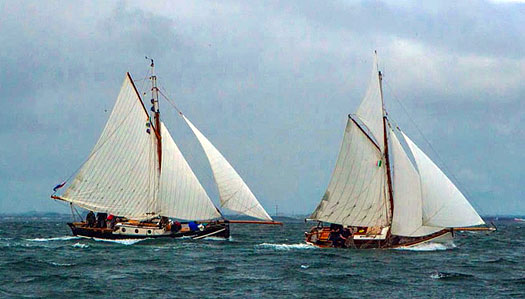
Dutch competition – the little Raven shows the big Cine Mara the way Photo: Barry O'Loughlin
As the forecast was for the brisk west wind to go light by mid-afternoon, the course went no further seaward than the North Burford Buoy. The reaching start was lively with some very long bowsprits pointing every which way and travelling at high speed, but everyone emerged still more or less intact and at the North Burford Joe Pennington's mighty Master Frank – her crew including longtime Galway Hooker/Arctic hand Paddy Barry – was in the lead. But Ainmara, having got herself into the hunt by sending up her jib topsail as the breeze eased, was settling into the groove and revelling in conditions that might have been made for her. She was clear ahead by the next turn at the Rosbeg East, and though the final leg from Rosbeg South to a finish at Drumleck was tricky as the tide was by now sluicing eastward across it to make it a challenging beat. But thanks to the party in the National YC the night before, Ainmara had Mermaid National Champion Jonathan O'Rourke as guest helm. He sailed the old Kearney yawl so well she had a very clear handicap win after taking line honours by a country mile.

Sean Walsh's Tir na nOg and Paul Holden's Chick Pea battling it out. Photo: Barry O'Loughlin
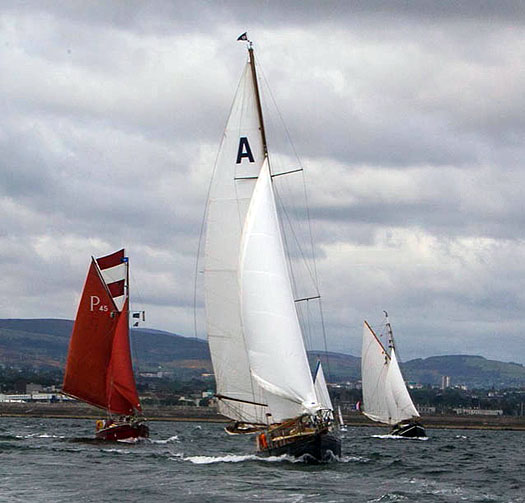
Ainmara getting into her stride. Soon afterwards she hoisted her jib topsail, and was gone Photo: Barry O'Loughlin
While DBOGA Honorary Secretary Sean Walsh had a cracker of a race with his Heard 28 Tir na nOg, his crew including OGA National President Mike Shaw, when the numbers were crunched it was the lovely little Raven from Makkum in The Netherlands which took second, with Tir na nOg third. The top ten corrected time placings for the Leinster Plate give a useful overview of the widespread nature of the OGA Fleet:
Leinster Plate 2013 1st Ainmara (36ft yawl 1912, Richard Gomes, Strangford Lough) 01:45:39, 2nd Raven (Hess 28, F J Schotmann, Makkum, Netherlands) 01:54:26; 3rd Tir na nOg (Heard 28, Sean Walsh, Poolbeg) 01:55:56; 4th Verve (37ft Arthur Robb yawl, 1964, Brian Comerford, Dun Laoghaire) 02:07:15; 5th Master Frank (Manx Longliner, 1896, Joe Pennington, Isle of Man) 02:13:13; 6th Mona (Cornish Crabber, Denis Aylmer, Dun Laoghaire) 02:27:17; 7th High Barbaree (34ft Cornish Pilot Cutter, Tim & Liz Dodwell, Buckler's Hard, Hampshire, England) 02:27:46; 8th Chickpea (30ft Victorian cutter, Paul Holden, Howth) 02:28:39; 9th Cine Mara (42ft Galway Hooker, Rik Janssen, Schermer, Netherlands) 02:54:59; 10th Alice (Cornish Crabber, Mark Lynch, Howth) 02:56:59.
As the main fleet were finishing in the Leinster Plate, the Howth 17s were already making their way into Dublin Bay on their delivery race from Howth. In fact, two had arrived well in advance of the rest. These were Harriette Lynch's Echo and Ian Malcolm's Aura, which had come round to Dublin Bay hoping to do the Leinster Plate race. But having been late for the start, they strung along with the fleet nevertheless, and then when their doughty skippers and crews saw that the fleet clearly weren't going round the Kish as had been suggested months ago, they simply sailed their little boats out to the lonely lighthouse on their own, and having sailed round (it's in fine order, but smelling mightily of unconstipated seabirds) they sailed back again in plenty of time – despite a two-and-a-half hour beat in from the Kish - to join the party at Poolbeg. seabirds) they sailed back again in plenty of time to join the party at Poolbeg.
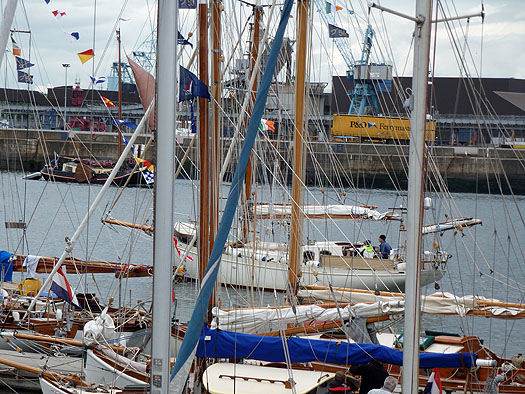
The successful circumnavigator of North America, Andrew Wilkes and Maire Breathnach's 44ft steel-built gaff yawl Young Larry, comes into Poolbeg to join the party. Photo: W M Nixon
And what a party it was, rounded out by the presentation of the Leinster Salver to Dickie Gomes of Ainmara. Most of the Old Gaffers, having sailed so far to get to Dublin Bay, had never intended to go straight out again for a race. So for those of us arriving in late on Saturday afternoon to join the fleet for the first time, the effect of the crazy kaleidoscope of boats – everything from Rachel Leech's 64ft Tjalk Ebenhaezer brought across Ireland via the Grand Canal from Athlone, right down to the 12ft Droleen dinghy from Bray – was electric.

Here they come – the first of the Howth 17s arrive at Poolbeg after a race fom their home port had ended in a dead heat between three boats. Photo: W M Nixon
And then the main fleet of the Howth 17s arrived, tacking up the river with jackyard topsails set. Somebody should have put up a trophy for their delivery race from Howth to the entrance to Dublin Port, for it was an epic sail in itself, much of it against the tide. With the distance to be sailed, it was assumed that a clear leader would have emerged by the time they reached the finish, so they had no-one at the end of the Bull Wall to time them in. It says everything about the spirit of the class that the three leaders were so close coming into the river that the Howth 17 Howth-Poolbeg Race 2013 has been declared a dead heat between Deilginis (Massey syndicate), Oona (Peter Courtney), and Rita (John Curley & Marcus Lynch).
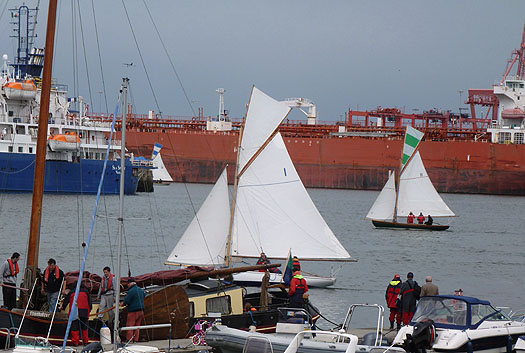
Rita (1) and Deilginis (11) dead heated at the finish of Saturday's race from Howth, and they each won a race on Sunday.
Photo: W M Nixon
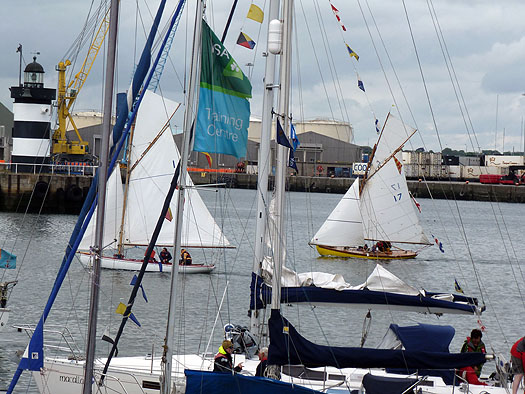
Rita (1) and Oona, the third boat in the dead heat in Saturday's race. Photo: W M Nixon
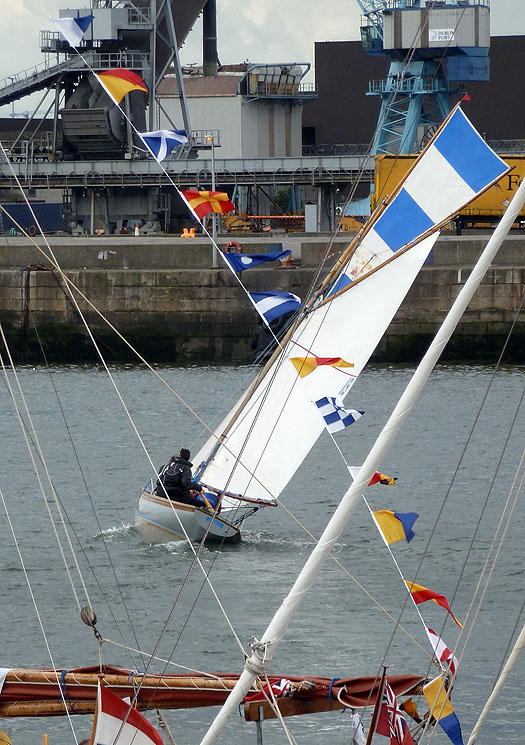
Looking every inch a classic, Brian & Conor Turvey's Howth 17 Isobel turns elegantly to windward in the Liffey. Photo: W M Nixon
The Saturday night saw the Poolbeg complex a hive of socializing with boat talk and boat visiting and all the usual things that sailors get up to in port. We've already given a hint of the variety of boats, but the gathering in Poolbeg also included serious stuff like the mighty 55ft Annabel-J (Philip Cogdell), authentically built in 1995 with inspiration from classic Bristol Channel Pilot cutters, and the hugely impressive 44ft steel gaff yawl Young Larry (Andrew Wilkes and Maire Breathnach), which last year completed an extraordinary cicumnavigation of North Amrica, having transitted the Northwest Passage in one season.
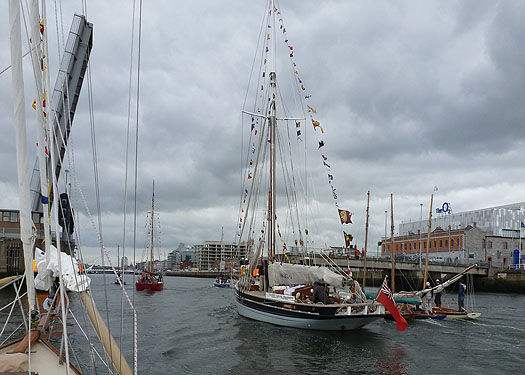
Through the bridge. The big pilot cutter Annabel-J and a trio of Howth 17s heading for the Eastlink. Photo: W M Nixon
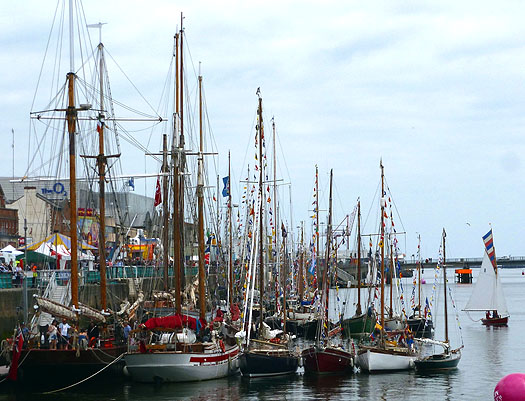
The fleet's in town – the two boats right foreground are the white 31ft cutter Witch (built 1898) and the 25ft Marguerite (built 1896). Photo: W M Nixon
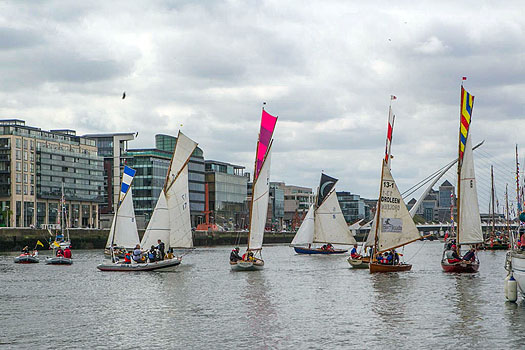
History in the making - Howth 17s and the lone Bray Droleen in the heart of the city Photo: W M Nixon
With boats like that all in the one place, you could have spent a week in detailed examinations. But soon enough it was Sunday morning, and at 1100 hrs the entire fleet passed through the raised Eastlink Bridge for a good-natured raft-up along the quays and up to the MV Cill Airne (the restaurant boat), aboard which Dublin Bay OGA President Tim Magennis was over-seeing commentary duties during a hectic day which included two in-river races by Howth 17s, a crazy and wonderful maritime ballet by Dublin Port's state-of-the-art multiple movement tugs, the Shackleton and the Beaufort, there were informal parades by all sorts of craft including an authentic currach with an even more authentic piper, then too there was Yoshe the famous old gaffer dog from the Netherlands in his little dinghy powered by a vintage Seagull outboard, a Sikorski helicopter from air sea rescue put in an appearance, and somewhere in the middle of it all the Howth 17s put in two races in very light conditions which made it like a sort of waterborne mystery play, but they still got two good sets of results even if the wind died before they could sail a final race.
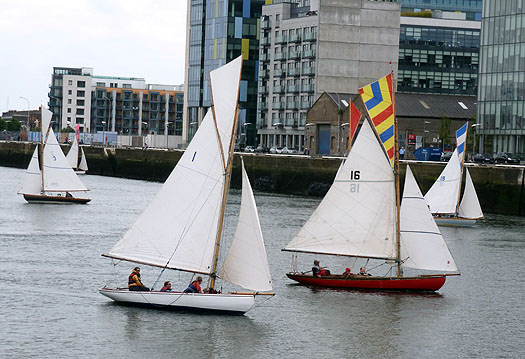
There was a very close river race between Marcus Lynch sailing Rita (1) and Davy Jones sailing Eileen (16) Photo: W M Nixon

Deilginis (Team Massey) won the second river race. Photo: W M Nixon
So it was announced that instead of having to make do with only one winner, they were ahead of the game – they'd finished the day with two champions. The first heat was really close, with Rita (Marcus Lynch and John Curley) staving off repeated challenges by Eileen sailed by Davy Jones and George Curley, with Conor & Brian Turvey in Isobel placing third. The other heat, in even flukier conditions, saw the Massey team in Deilginis come from nowhere by working a private air along the north side of the river (they're Northsiders of course) to take a clear lead from Peter Courtney in Oona, with Silver Moon, sailed by Windsor Laudan and Steph Ennis, placing third.
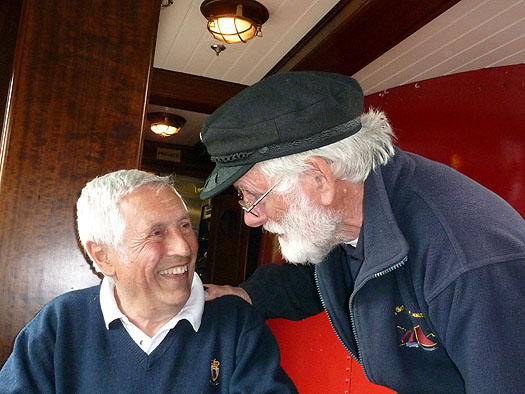
Senior sailors. Tim Magennis (President DBOGA, right) congratulates Dickie Gomes, skipper of Ainmara and winner of the Leinster Plate 2013, aboard the Cill Airne during the riverfest. Photo: W M Nixon
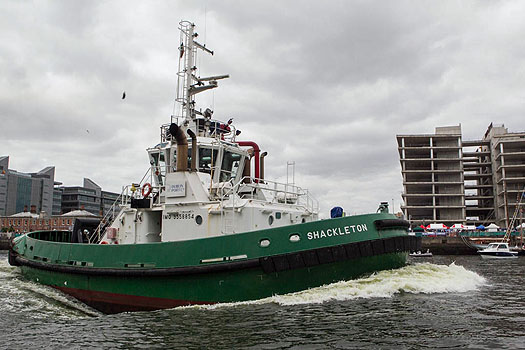
Dublin Port's state-of-the-art tugboats gave a fantastic display Photo: Barry O'Loughlin
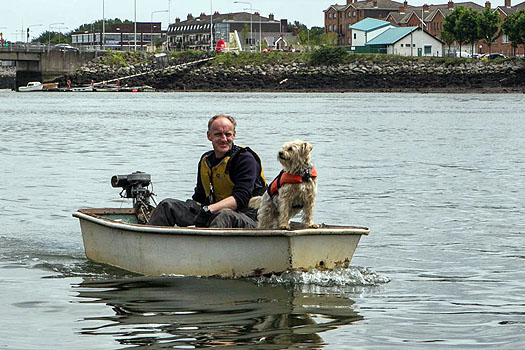
Old Gaffer pooch Koshe sailed to Dublin from The Netherlands, and toured the Liffey with his vintage Seagull outboard.
Photo: Barry O'Loughlin

Sails in the city Photo: Barry O'Loughlin

Water music, Liffey style Photo: W M Nixon
Needless to say when the Eastlink Bridge lifted again at mid-afternoon, despite highfalutin plans for a parade of sail everyone seemed to try leaving at once, but fortunately good humour prevailed on all sides. Invitably with the nature of a project like the Round Britain Challenge, some boats were already starting to think of moving on towards the next major gathering at Belfast this weeknd. And not surprisingly in a crowd of gadgeteers like the Old Gaffers, there were those for whom the siren call of the Isle of Man at TT time was just too good to resist.
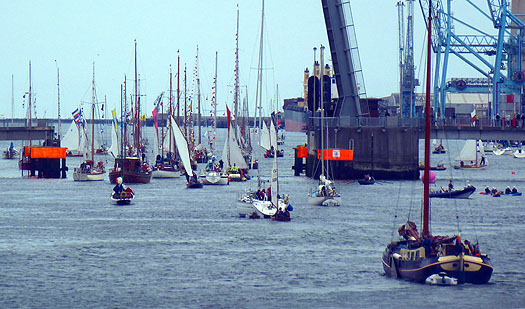
When the Eastlink lifted, everyone tried to leave at once, but there were no bumps. 64ft Ebenhaezer from Athlone (foreground) had the sense to wait. Photo: Barry O'Loughlin
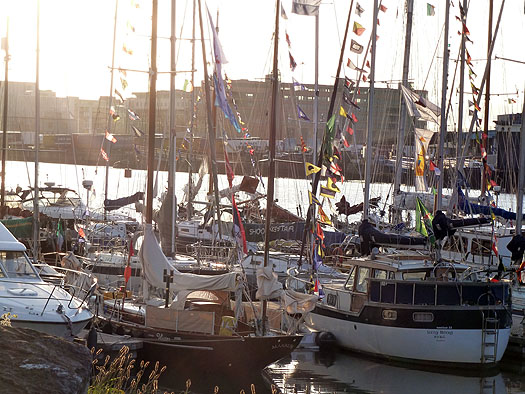
Winding down – summer evening at Poolbeg Photo: W M Nixon
Through the Sunday night, boats were quietly slipping away from the convivial throng at Poolbeg to head northeast for Peel under the Manx hills, and petrolhead heaven. But for others, it was a matter of gentle morning departure, after fulsome thanks to the kind hosts and wonderful hospitality of Poolbeg, away for a gentle and very sunny Bank Holiday Monday rounding of the Baily with Annabel J and Ainmara together, the big pilot cutter on a very leisurely progress for the first day with a new crew, planning a stop for lunch at Lambay and an overnight at Skerries, while the old yawl, her prizes secure, went on past the roseate terns rampant at Rockabill, and fetched up that night comfortably in Ardglass.

Quiet day at sea – Annabel-J on passage towards Lambay on Bank Holiday Monday Photo: W M Nixon
But for some really keen Old Gaffer sailors, Bank Holiday Monday in Dublin Bay meant the first race for the Asgard Trophy, created by conservator John Kearon from bits saved from the saving of Erskine Childers' Asgard up in Collins Barracks. With the high pressure system well settled on Ireland, it was into the afternoon before there was a hint of a breeze, but the fleet had waited in patience, and they got a race and a result.
This time round, it was Tir na nOg's turn to take the prize by 63 seconds from Denis Aylmer's Mona, which means that over the two races of OGA50 racing in Dublin, Sean Walsh's cutter is the overall winner. He certainly deserves it – the quiet but steady effort as DBOGA Honorary Secretary that Sean put in over the winter to bring it all together made for a fantastic time for everyone.
Asgard Trophy 2013 1st Tir na nOg (Sean Walsh, Poolbeg) 00:52:11; 2nd Mona (Denis Aylmer, Dun Laoghaire) 00:53:14; 3rd Verve (Brian Comerford, Dun Laoghaire), 00:53:48; 4th Dreva (1936 34ft gaff cutter, Joe Ormond, North Wales) 00:54:53; 5th Marguerite (1896 25ft gaff cutter, owned Tim Magennis Dun Laoghaire, sailed Sean Cullen) 00:57:03.
This weekend, the fleet are well gathered in the new Belfast Harbour Marina right beside the extraordinary Titanic Belfast centre, close to the newly-restored ship Nomadic, the "miniature Titanic". She is so newly re-commissioned that tonight's OGA50 party on board is the first official function on Nomadic in decades. And then the fleet heads on, some to return directly to their home ports, others to continue the circuit via the Caledonian Canal, and others like Annabel-J making a real job of it by going north to the Shetlands before finally shaping their course southwards to many hospitable ports before the OGA50 Challenge reaches its conclusion with a mighty gathering in Cowes in mid-August.
We enjoyed our new friendships made at Poolbeg in the glorious first weekend of June. Now we'll follow their summer-long progress with special interest, these lovely people with their long bowsprits, their weird and wonderful boats, and their engaging enthusiasm.
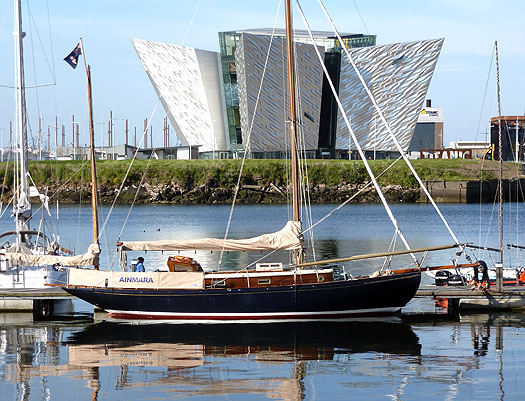
Where is everyone? Ainmara was one of the first to reach Belfast, and is seen here berthed at the new Titanic Belfast centre on Tuesday evening. The OGA50 party continues there tonight. Photo: W M Nixon
Comment on this story?
We'd like to hear from you! Leave a message in the box below or email William Nixon directly on[email protected]
WM Nixon's Saturday Sailing blog appears every Saturday on Afloat.ie
Follow us on twitter @afloatmagazine and on our Afloat facebook page
101 Year Old Gaffer Set to Return to Ringsend Roots
#DublinRiverfest- The 101 year old cruising yawl Ainmara is among the many participating vessels to celebrate the Golden Jubilee of the Old Gaffers Association (OGA) at the Dublin Port 'Riverfest' this Bank Holiday Weekend (1-3 June), writes Jehan Ashmore.
The 36ft Ainmara, is to make her centennial return to the River Liffey having been built downriver in Ringsend just over a century ago in 1912. She is owned by the noted Strangford Lough sailor, Dickie Gomes who has spent nearly three decades on her restoration.
So what is a gaffer?... it is a nautical terminology for a boat that has a main sail with 4 sides rather than the typical triangle you see commonplace on modern yachts.
The gaff is the wooden pole across the top of the sail, which is a pretty old type of rig, however by the early 20th century it was largely replaced by the triangular Bermudan rig, which was thought more efficient. As for lovers of gaff-rigged craft, the OGA still think gaff is best!...
Ainmara is part of a visiting fleet of OGA gaffers currently at sea, some of whom will be heading this way to compete in the Dublin Bay events over the course of the weekend.
The flotilla will take part in the annual Traditional Sailing Boat Rally of the Dublin Branch of the OGA to be held at Poolbeg Boat and Yacht Club & Marina in Ringsend over the long week-end.
Not to be missed is the highlight of OGA 'Parade of Sail' 50th anniversary celebrations this Sunday 2 June (starting at 4pm), where the largest gathering ever of East coast gaffers and from the UK will meet in the confines of the Liffey. According to the festival programme the flotilla of tallships which are due to arrive from today will also be involved.
Such a setting presents both action and colour on the river as the Old Gaffers are to form a striking contrast against the modern backdrop of the Samuel Beckett swing-bridge with its sail-like harp-strung construction.
Irish Trad Boat Leader is Veteran of Gaffer Global Circuit
#vintage boats – The season-long Golden Jubilee cruise of the Old Gaffers Association starts to roll this weekend, with vintage boats from the Thames Estuary setting out tomorrow to rendezvous in the Orwell estuary in Suffolk with character boats already on their way from Holland. And when the growing fleet reaches Dublin Bay for major events between May 31st and June 4th, they'll find the welcoming party is headed by a sailor who has been round the world under gaff rig.
The Old Gaffers Association was barely a year old when the current President of the Dublin Bay branch set out on a global circumnavigation under traditional rig in an already famous classic ketch, a vessel whose status was to become almost legendary when this voyage was completed.
It was the morning of Sunday 21st February 1965 when the 47ft Sandefjord slipped her lines from a quayside packed with friends and well-wishers in Durban, South Africa, and headed seaward down the harbour with an accompanying fleet. Instantly into open ocean at the pierheads, she was soon heading west for Cape Town, reeling off the miles on a close reach as her goodwill flotilla peeled off one by one to head back to the shelter of the great port. Sandefjord was now alone on the high seas
But the friends and supporters were to be out there again in increased numbers two years later to greet her when she returned from the eastward, with 30,729 miles completed in a classic global circumnavigation which had gone on from Cape Town through the South Atlantic to the Caribbean, thence to the Panama Canal and on to the Galapagos, then on across the wide blue waters of the Pacific to Polynesia and eventually to Sydney in Australia. From there it was northwards, cruising through the Great Barrier Reef and on into the Indian Ocean, then southwestward on the final long transoceanic leg, back to a rapturous welcome in Durban.

Tim Magennis in 1965 after he'd joined Sandefjord's crew
It is Tim Magennis, longtime member of the Dublin Bay OGA and its current President, who gives us the direct link to this fine voyage. With a boyhood in the coastal village of Ardglass in County Down, most of his early seagoing experience was with summer jaunts on one of the local fishing boats. But having shown a youthful a talent for journalism, he went straight into it from school, soon finding his way to national newspapers in Dublin.
From there, he went on to work in newspapers in Africa in the late 1950s, and by the early 1960s found himself on the staff of the largest daily in Durban. Always drawn to the sea, he was fascinated by Durban's port, the largest in South Africa. Yet despite its size he noted that his paper gave port matters no prominence whatever. When he pointed this out to the editor, Tim was promptly detailed off to write a regular column about maritime affairs. Hanging out on the waterfront became part of his job.
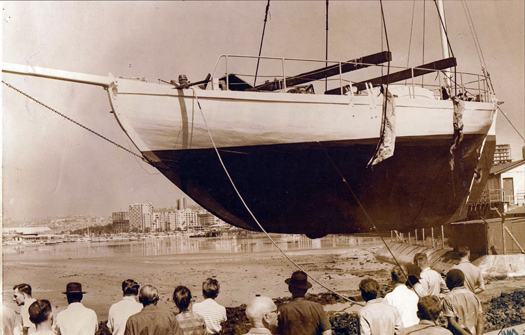
Sandefjord being craned in after her restoration in 1964-65
Through this, he met up with the people restoring Sandefjord, a classic former Redningskoite designed by Colin Archer (1832-1921), Number 28 constructed in 1913 by Jens Olson at Risor Batbyggeri. She was one of the last of the type specifically for rescue work to be built to the designs of the famous Scottish-descended Norwegian naval architect, who had also designed and built Erskine and Molly Childers Asgard in 1905. Although motor-powered lifeboats had been about since G L Watson pioneered the first one for the RNLI in 1904, sail and oar continued to play a prominent role in many rescue services, and the exclusively sail-powered Sandefjord accompanied the Norwegian fishing fleet from 1913 to 1934.
Stood down from rescue duties after 21 years of gallant service, in 1935 she was bought by noted Norwegian ocean voyager Erling Tambs, who wanted to provide a Norwegian presence in the forthcoming Transatlantic Race from Newport, RI to Bergen. Crossing the Atlantic westward in May 1935, Sandefjord was pitch-poled with the loss of one crewmember. But Tambs and his remaining shipmates still managed to nurse her to Newport, where they sorted the damage, and then raced back across the Atlantic.
In 1939, with World War II imminent, Tambs sailed her out to South Africa, where she was sold to Tilly Penso of the Royal Cape YC, who kept her with loving care for twenty years. She became a cherished part of the Cape Town sailing scene, with her rig simplified for family sailing by conversion to Bermudan ketch.
With Tilly Penso's death in 1959, she was sold by his estate, and went through a quick succession of owners. Though her gaff rig was restored, she was slowly going downhill, and by 1962 was more or less abandoned in Durban. There, already on the slide to becoming a rotting hulk, she was spotted by a restless young South African of Irish descent, Patrick Cullen (23), who despite having a very young family, had notions of a seagoing adventure. His brother Barry (24) was a qualified master mariner, and the two of them saw the potential in Sandefjord.
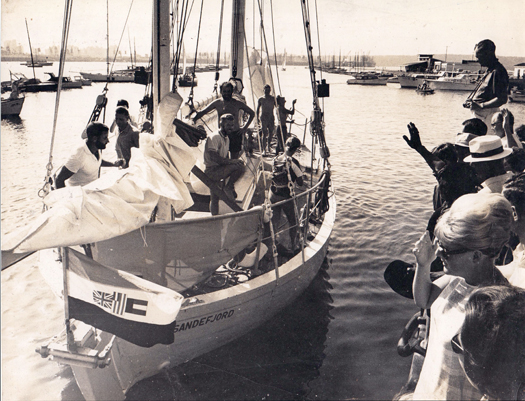
Slipping the lines - departure from the Durban quayside
The notion of a two year voyage round the world to the romantic South Seas took shape, with a proper film being made of it to make their fortunes afterwards. They managed to buy Sandefjord with the support of their mother in 1963, and secured a place on the Durban waterfront for a restoration project which soon became almost a re-build. But these were two very determined young men, and soon they were attracting like-minded spirits to join their project. It was all done in a very businesslike way, with crewmembers being required to sign a clearcut contract and commit one thousand rands up front towards the expenses of the voyage.
It was in those heady days of hard preparatory work and boundless horizons that the recently-appointed Durban maritime correspondent met up with them. At 32, Tim Magennis may have been a few years older than the next oldest member of Sandefjord's crew, but he always seemed much younger than his years - he still does at 81 – and within days he was being swept up with shared enthusiasm. He jacked in his dream job, though agreeing to file reports from around the world and write up the story for the paper on their return, and signed on as the final member of Sandfjord's crew of six, throwing himself into the final frantic months of preparing the ship for the great voyage.
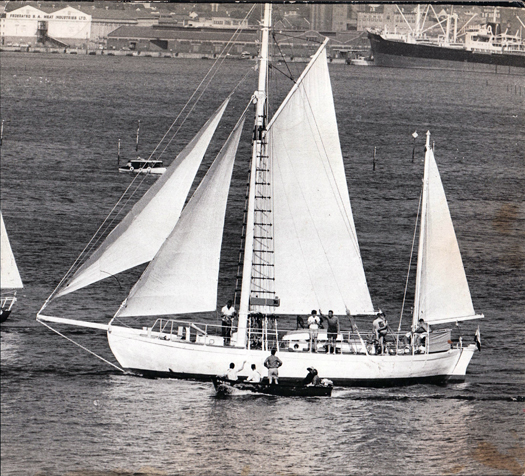
Getting under way from Durban

The departure from Cape Town had a fleet of well-wishers which included two boats of the Royal Cape OD class (see Sailing on Saturday 02/02/13)
It was a classic cruise, all the better for being at a time before sailing became overly regulated and monitored. Thus although they'd a painfully slow passage from Panama out to the Galapagos, at one stage taking an entire week to make good one hundred miles, once they got to those extraordinary islands they were able to cruise among them with a freedom denied in today's heavily regulated environmental protection of that unique place.
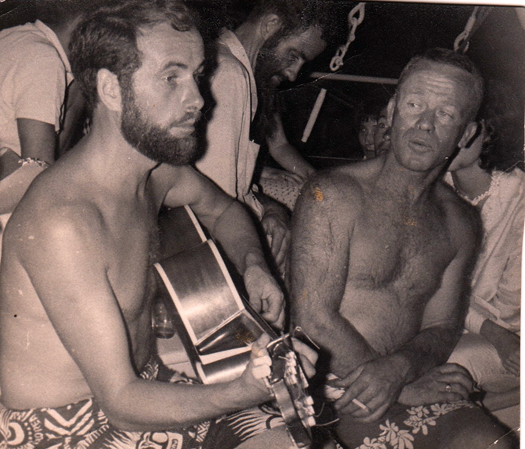
The President of the DBOGA in his days as an ocean busker – Tim Magennis with his guitar in the South Seas aboard Sandefjord.
Tahiti was still a place of romance before mass tourism made it blasé, and among the Pacific islands Tim's talents with the guitar were much in demand. But they surely paid for their lotus eating in the South Seas. The passage on to Sydney, far from being tradewind bliss in southeasterlies, became a slog almost all the way against unseasonal headwinds which culminated in yet another gale on the final night at sea. It brought down the mizzen mast around their ears, and there was a fierce struggle to secure the broken spar on deck.
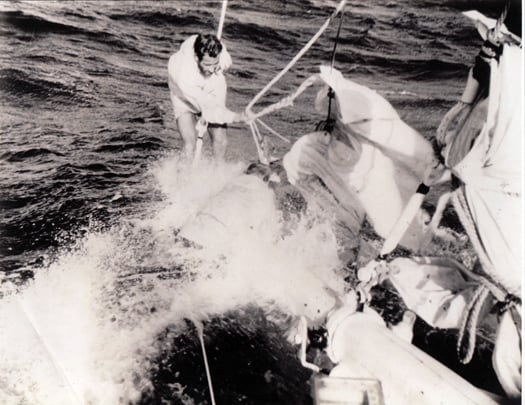
Bowsprit work in the open ocean
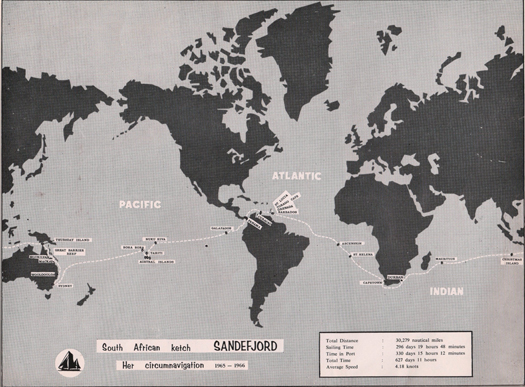
So who needs Europe? Sandefjord's circumnavigation of 1965-67

Sandefjord living the South Seas dream
But when they finally arrived exhausted and battered at the Cruising Yacht Club of Australia in Rushcutters Bay, they'd come to the right place. After taking 50 days for a passage which should have taken only about 33, with stores down to just 20 cans of baked beans, they were distinctly peckish. However, lunch on arrival at the CYCA was just the job, with enormous steaks. Tim is slim now, as he was then. Yet like the rest of the crew, having enjoyed one enormous Australian lunch, he simply sat on and ate his way right through a second one, with all the trimmings.
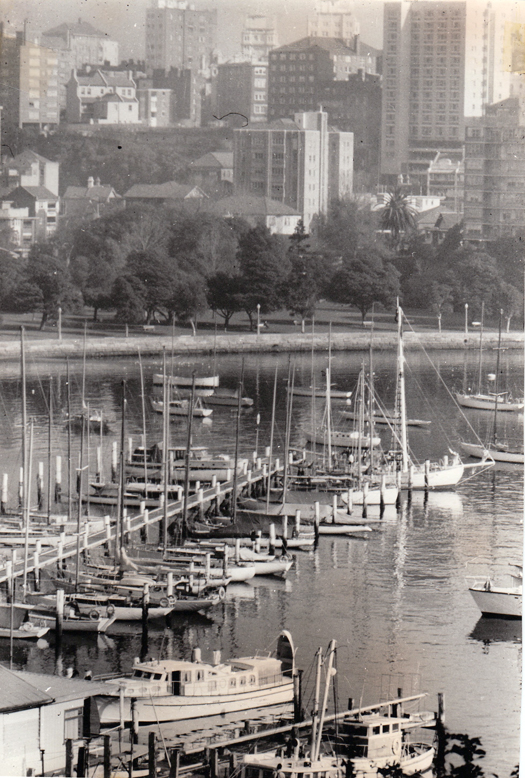
Urban paradise – the CYCA provided a haven for recuperation and repair in Sydney, with Sandefjord's mizzen re-rigged after breaking on the last night at sea
They gave a boat a complete refit at Sydney, glued and fastened the saved mizzen mast, and then headed on north for the Great Barrier reef. But inevitably at this final stage of the voyage, resources were becoming stretched, so when the gearbox on their Perkins diesel gave up the ghost, they sold the otherwise sound engine for 400 much-needed Australian dollars at Thursday Island and completed the rest of the voyage, along the north coast of Australia, across the Indian Ocean and home, under sail only.

A little bit of fund-raising with the sale of the engine at Thursday Island
Their average speed for the entire cruise was 4.18 knots, but when you see the one hour and 54 minute film – which has recently been re-mastered and is well worth viewing for this glimpse of life when the world was a simpler place – you soon realize that with half a decent breeze, the handsome Sandefjord could trot along in some style. And for her young crew, it was simply the time of their lives.
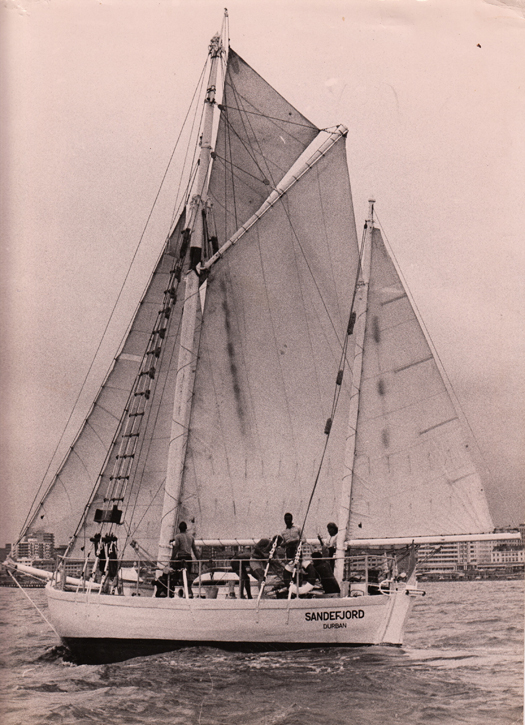
The triumphant return. Her sails may be showing evidence of hard work, but Sandfjord arrived back in Durban in fine shape.
Back in Durban, reality intervened. Tim found himself locked into a hotel room until he completed the account of the voyage for his newspaper. Then a message from home from an older brother, an officer in the Irish army, was a three line whip – he was to get back to Ireland soonest for their parents' Golden Wedding anniversary.
He returned to an Ireland considerably changed. In the late 1960s, the place was finding new and very welcome vitality. He never returned to Durban, but married Ann and settled in Dun Laoghaire on the shores of Dublin Bay, perfectly fitting his new job as PR for the Irish Tourist Board. He became a voice for Ireland. You could always be sure that the usually gruff William Hardcastle of the BBC's World at One would have a smile in his voice after chatting on the air with Tim Magennis about something of interest in Ireland.
As for Sandefjord, Patrick Cullen sailed her with his family in the Cape Town to Rio Race of 1971, and then cruised north through the Caribbean to New York and on to Mystic Seaport in Connecticut, where she was based from 1972 to 1976. She was sold there by Patrick and Barry in 1976 to Erling Brunborg, who sailed her home to Norway.
Brunborg, a stalwart of the Colin Archer world, eventually sold her in 1983 to Petter Omtvedt, who in turn spent ten years on a massive re-build, making her exactly as she'd been as a Redningskoite. When this was completed, she was bought in 1993 by Gunn von Trepka who – with her husband Alan Baker – has completed many Tall Ship Races in European waters as family sailing ventures. And as this year is Sandefjord's Centenary, there'll be a mighty party in Risor at the end of August which hopefully will be attended by all the surviving members of Sandefjord circumnavigating crew, though sadly Pat Cullen, who had the first spark of the idea of the world voyage, died some years ago.

The Centenarian – Tim Magennis aboard the restored Sandefjord in Risor in Norway, where she will celebrate her hundredth birthday in August 2013
Needless to say, Tim Magennis will be in the heart of the Centenary party, the father of the crew. But meanwhile, he has much to attend to in Dublin. With retirement he has been able to focus even more strongly on his love of sailing and maritime heritage, and it was very right with the world when he was acclaimed as the new President of the Dublin Branch OGA in the Autumn of 2012, no better man with the Golden Jubilee Cruise arriving at the end of May.
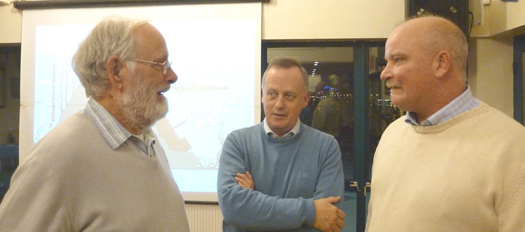
Tim Magennis (left) seen recently at a DBOGA meeting with fellow gaffers Ian Malcolm and Sean Cullen
His own boat these days is the 25ft Marguerite, a lovely little clipper-bowed gaff sloop designed in 1896 by Herbert Boyd, who later designed the Howth 17s in 1898. A great friend and fellow owner of another vintage Boyd boat, the 26ft Eithne from 1893, is Patrick Cullen's son Sean, who is very much an Irish seafarer these days – he commands one of the national maritime survey vessels, a long way indeed from racing aboard Sandefjord from Cape Town to Rio as a very young seafarer in 1971.
Tim's seagoing interests are many. He sailed many miles offshore with Don Street of Glandore aboard Don's famous ocean-crossing Iolaire. And more recently, while sailing across the Bay of Biscay aboard the square rigger Jeanie Johnston on a pilgrimage with a difference to Santiago de Compostela, his mobile phone rang, and the connection lasted just long enough to tell him he'd become a grandfather for the first time.
That's the way it is with Tim Magennis. There's always something new on the horizon. And there's quite a past too, for this is a man who once upon a time sailed right round the world on a fine gaff ketch when all the world was young, and everything was possible. So when the world of gaff rig comes to Dublin Bay in six weeks time, there'll be someone there to welcome them, a man who really does know what seafaring under gaff rig is all about.
Old Gaffers Hit the Liffey
Organised by the Dublin Bay Old Gaffers Association and the Poolbeg Yacht and Boat Club, it will also feature skiff racing involving competing men, women and mixed rowing crews from Wicklow, Dun Laoghaire, Arklow, Greystones, Bray and two entries from Ringsend, assembled by the East Coast Rowing Council.
The stretch of the river near the Poolbeg club will be a scene of constant craft movement from the Beckett and East Link Bridges downriver to entrance to Dublin Bay. The skiff racing will be over a five- hour period from 2pm.
The best vantage point for the public to be up close to the rowing action will be East Link Road from the yacht club to the East Link Bridge.
The DBOGA expect gaffers from Wales, Northern Ireland, the Isle of Man to join local craft in a parade upstream and downriver to the entrance to Dubllin Bay in a parade of over 20 craft dressed overall.
Included in the visiting craft will be WILMA, A 60-foot Baltic Trader from Port Pnryn on the Menaii Straits, the Scots Zulu Breccon Lass of the Poolbeg club, the Galway Hooker, Naomh Chronain, built by hooker enthusiasts in Clondalkin, the gaff sloop Marguerite built in Malahide 114 years ago and the engineless Happy Quest from Milford Haven.
The DBOGA's special guest for the weekend will be the noted shipwright, John Kearon, who leads the small team currently completing the conservation of ASGARD and headed for future display in the National Museum at Collins Barracks.
John Kearon has honoured the association with a special ASGARD trophy made up of original ASGARD timber and portions of new wood that has gone into her hull. This will be the major prize for all future DBOGSA events and will be competed for over a five-hour race in the bay on Saturday scheduled to start at 2pm.
That same evening victuals for the hungry racing crews will consist of a hog roast on the club premises followed by prizegiving and the first presentation of the new ASGARD Trophy.



























